#which is arguably worse than this one because it’s out of my comfort zone
Text
I have once again gotten distracted by other things when I should be drawing
#and by this I mean literally all day. for *7+ hours* I have been distracted by other things.#I have a request that’s officially been in my inbox for over a week now#I’m SORRYYY#this piece is taking AGES#I’m proud of it so far but oh my god I wanna stab it#before it stabs me which I fear it might#I’ll be so relieved when it’s finally finished#...and then I’ll have to work on my OTHER big art wip#which is arguably worse than this one because it’s out of my comfort zone#and that’s not to mention all of my writing wips I still need to work on.....#being a creator is EXHAUSTING I didn’t sign up for this lol#//#echo shouts to the void
10 notes
·
View notes
Text
Neurodivergent Link Headcanons (BOTW)
Here are... my headcanons for ND Link! I’ve tried to put them in fairly concise bullet points so hopefully they make sense. A lot of the autistic/adhd traits overlap, but I’ve put them in separate sections just to try and make this easier to read
Headcanons under the cut!
Autism:
- sensory seeking! Link needs constant stimulation and his preferred sensory input is touch, whether it’s rubbing his palms over tree bark or smushing his face in soft pillows. Auditory and visual stimulation are good too, but he’s very, very tactile. Of course taste is another big thing for him, he loves cooking and trying out new food and exploring different tastes, whether it’s sweet or spicy or sour, the stronger the better.
- he stims. SO MUCH. he has so many stims that I’m going to make a separate post to include all of them, but the main ones are rocking and flapping his hands.
- very good with gross motor skills, generally good with fine motor skills but there are a select few he struggles with - he has very poor handwriting, has to focus tying shoelaces, struggles washing his hair, overestimates how hard he’s brushing his teeth and makes his gums bleed
- poor interoception. Has a hard time telling when he’s hungry, or tired, or in pain. Sometimes he will walk around with an injury and not realise until he sees blood. Finds it hard to recognise negative sensations and his body tends to just interpret them as discomfort.
- very good at recognising and deciphering expressions and body language, but not particularly good at (or interested in) emulating it. He’s very astute and can pick up on microexpressions and hidden glances and the like, and can work out people’s true feelings or motivations, but in a social context he’s not necessarily good at responding to it.
- easily picks up on small details and notices things others don’t - this can be related to the former point, but also just in general. Also very good at pattern recognition which lends itself well to solving shrines.
- nonverbal. Mostly uses sign to communicate, or noises (usually with animals or people he’s comfortable with). Can occasionally manage to speak in short bursts when he has to, but it’s few words and usually stuttered, and if he gets at all stressed (which he often does if he’s forced to talk) he won’t be able to say much of anything. He can talk a little around Sidon and Zelda, they’re pretty much the only he feels comfortable enough to be verbal with, and they understand the way he talks and are patient when he’s slow or gets words mixed up.
- difficulty with eye contact. Either too little or too much, though usually it’s the former. He only tends to stare at people if he likes them, or if he’s angry with them or trying to make them uncomfortable
- echo echo lalia. Loves to repeat fun noises, especially animal noises, but sometimes words (sees a dog and just goes doggy doggy doggy doggy doggy for the next hour). He does this with sign as well, but tends to prefer making fun mouth sounds
- special interests in food and horses! Those twins at the stable were right. That’s all that’s on his mind. Food and horses. He really loves trying out new ingredient combinations and exploring different tastes. And he knows a great many horse facts.
- forms connections with animals more easily than with people. This is partly because when he first left the Shrine of Resurrection he was alone in the wilderness, and partly because he doesn’t really talk, but it’s also just an autism thing. People are friendly to him, but he doesn’t tend to form deep connections with them like he does with animals.
- can tell the time by the position of the sun in the sky but can’t read a clock. What are those numbers on the slate. It’s a mystery!
- has mild visual processing issues, mostly struggles to focus on things like screens or pages, things look blurry or strangely coloured, or have a weird overlay.
ADHD:
- inattentive AND hyperactive AND impulsive, a triple threat
- gets the Zoomies. Often ends up conking out afterwards. Will run around chasing frogs all day and then just fall asleep in the middle of a field
- Can’t Stay Still. Has To Bounce Leg.
- nonexistent sleep schedule. Granted, he doesn’t sleep well or regularly what with travelling all over Hyrule, but even without that his sleep would be terrible
- sometimes zones out in the middle of a conversation. Good luck guessing whether he’s having a seizure or if he’s just thinking really hard about jellyfish
- alternatively, he will hyperfocus. Very good at hyperfocusing on shrines, or anything that involves challenges. Also good at hyperfocusing on physical activities.
- executive functioning… what’s that. Link doesn’t know. Link can’t organise to save his life and honestly thank god for the sheikah slate because without it he’d be screwed. Cannot schedule, cannot plan, cannot organise.
- thrillseeking!!! He gets easily understimulated and needs adrenaline to survive. Will do anything remotely dangerous for fun and profit.
- often thinks very quickly, usually jumping quickly from one thing to the next, but only about certain subjects (usually related to animals, nature, food, chaotic activities) and usually when he’s full of adrenaline. Although other times, especially when he’s tired, it’s just. Dial up noises. Head empty
- focus juice… for mentally taxing activites? Nonexistent.
Expressive language disorder:
(It used to be separated into receptive language disorder, expressive language disorder, or mixed, but these days it’s lumped together into developmental language disorder. However I use expressive language disorder for link because he specifically only has problems with expressive language (forming his own words) and not receptive language (understanding other people’s words)).
- gets words in the wrong order
- sometimes replaces a word with something else, especially if the signs are similar
- has difficulty with tenses (more so in verbal speech)
- often misses out words completely
- has quite a large vocabulary, but struggles with word recall. Will sometimes remember the word he meant to use hours later
- often flaps his hands in an attempt to remember a word, if he can’t think of it he will try to find an alternative
- c a n n o t s p e l l. Sometimes when he doesn’t know the sign for something, he’ll try to fingerspell it, but if the word is hard to spell he’ll try and find an alternative
- finds sign much easier than spoken language, because its grammatical structure (particularly how it uses tenses and combines language with muscle memory) is simpler to use for him, and because it’s so expressive he finds it easier to get his point across
- his language disorder is a part of why he’s nonverbal (as well as that he has a bit of a stutter), so signing in general is just much easier, though not everyone knows sign, and he isn’t fluent himself.
Epilepsy:
- has temporal lobe epilepsy
- mostly gets absence seizures and focal seizures
- absence seizures (essentially his brain ‘switching off’) are his more common ones. They usually only last a couple of seconds, and tend to look like he’s just distracted or zoning out (which he also does because of ADHD), though sometimes his eyelids will flicker, or if he’s walking or doing something he’ll suddenly stop, and go back to it like nothing happened. He isn’t aware of them at all. If they happen during something like a conversation with someone, he’ll just dismiss it as being distracted, though he does start to notice when he has longer absences and misses whole sentences, or has clusters of absences.
- focal aware seizures (auras) usually present as deja-vu, intense fear, or out of body feelings. He doesn’t realise they’re seizures for a while, since he experiences these anyway, and attributes the deja-vu to the memory loss, but eventually learns to tell them apart because his auras tend to come on very suddenly, though they can last a while
- he also gets focal impaired awareness ones, which tend to happen more when he’s very tired, especially when waking up/going to sleep. When he gets auras he’s still completely aware of his surroundings (and usually doesn’t have trouble moving, unless it’s a particularly bad one), but with impaired awareness he gets drowsy and confused, and won’t understand what people are saying
- usually his focal seizures stay just that, but sometimes they will become tonic-clonic seizures. This is usually only when he’s exhausted/injured/extremely stressed/otherwise worn down. Most of the time his auras come on soon enough to warn him he might have a worse seizure, so he can go somewhere safe (at least, once he realises he’s epileptic
- they’re arguably the mildest, but his absence seizures at the most dangerous, even though they’re usually short, because he gets no warning for them. He usually gets them a couple of times a day (especially waking up/going to sleep), but he gets them more frequently if he’s very tired, and if he gets absence clusters it makes it really hard to do anything.
- his main triggers are sleep deprivation, missing meals, extreme stress, and extreme heat. Which is unfortunate considering he spends his time running around Hyrule on no sleep and forgets to eat all the time.
in conclusion link is neurodivergent and i love him. thank u for ur time pls feel free to comment ur opinions and headcanons etc
#link#breath of the wild#the legend of zelda#also for context i am autistic + adhd#if u have epilepsy or a language disorder and i got anything wrong/said anything problematic here pls lmk!#mmm this took a long time to write bc i dont have brain cellsss#is rebloggable!#simply do not clown if u are not ND thank u#kokiri chatter
72 notes
·
View notes
Text
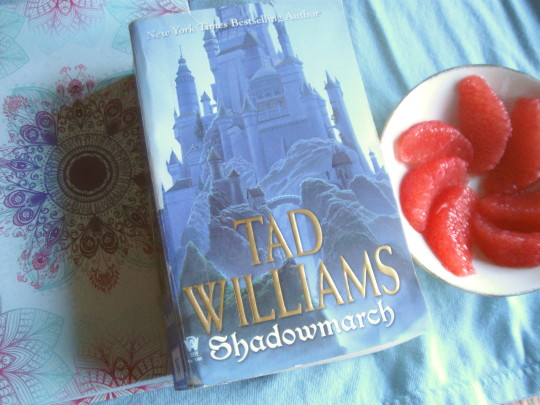
Books I Read in 2021
#83 - Shadowmarch, by Tad Williams
Mount TBR: 69/100
Beat the Backlist Bingo: Cover features your favorite color prominently
Rating: 1/5 stars
Well, that was a slog.
So I have a history with this piece of intellectual property. I was introduced to Williams as an author in college (1998) because several of the friends I made my first year were big fantasy nerds--no surprise there--and I was perfectly ready to move on from my high-school-era love of less sophisticated fantasy authors. I borrowed The Dragonbone Chair from one of those friends and off I went.
So in 2001 when news about Williams writing an online serial went around, and I saw the $15 price tag...well, I was a perpetually almost-broke college student still, and sure I spent money on books, but that was a high gateway, because a) I didn't own my own computer yet, I was borrowing friends' or using the computer lab to write papers and such; and b) sure, a chunky fantasy novel might be $7 or $8 in paperback, but it was portable, easy to reread whenever, and nobody had tablets or smartphones or e-readers yet, so an online serial publication was definitely not portable. Even fifteen dollars seemed like too much for the inconvenience of a book I could only read sitting at a computer, and couldn't read all of at once.
I was genuinely angry about this shift away from the paradigm, and much like Williams vowing this serial was online only and would never be published traditionally (which I distinctly remember but don't actually have a source for) I too vowed that I would never read it.
I held out much longer than he did, if my memory of that claim is even true. But I'm wishing now that I hadn't bothered.
This is bad. Not even close to the level of quality I expect from Williams, based on the earlier Memory, Sorrow, and Thorn series, as well as War of the Flowers--which was weird but I enjoyed it--and the Otherland series, which was even weirder and not always good, but yeah, I still enjoyed that too, for the most part.
Who am I supposed to care about in this book? I'm no stranger to multiple protagonists, but there are simply too many here, meaning none of them get the development time they would need to be interesting. I'm trying to wean myself from the complaint that protagonists need to be "likable," because a character can be a jerk and still be interesting, but few of these protagonists are particularly likable either!
1. Barrick is a whiny jerk who folds under pressure and abdicates responsibility to his sister, and then makes a spectacularly bad decision for no reason other than to set up some tension at the end, and his future arc. If it's because he's "mad," bad plot reason, and if it's because he's affected by the more general shadow-madness, well, I guess he could be vulnerable to it like anyone else, but that's pretty flimsy too.
2. Briony is a fairly standard "if only I weren't a woman, people would take me seriously" princess who doesn't fold as much under pressure but is dealt a really raw deal. I'll give her credit, she does legitimately try her best to rule her lands, but she's also kind of a whiny jerk like her brother, too.
3. Quinnitan is...pointless. Sure, I see how the end of her arc in this book echoes those of the Eddon twins, but there is no direct connection between her plot and anyone else's. And I mean that literally, if there's anything that ties her story to any other single part of the book, I simply do not see it, it's buried in lore or foreshadowing that was lost on me amid the sheer weight of nearly 800 pages of plodding narrative. I read all of her scenes constantly wondering why I should care, and the fact that her arc is a very basic harem plot, "I don't want to be a token wife but really what choice do I have?" sort of thing, doesn't help, because on its own it's incredibly unoriginal.
4. Chert is marginally likable, because he's arguably got the most defined personality and most personal growth in the book, as a person of a "little" race who is distinctly not human--I get a mix of gnome and dwarf, with a faint whiff of Podling from The Dark Crystal--and who deals with an unexpected foundling by taking him into his family and trying to make it work, even when that foundling is really a big blank space in the story who still manages to get into trouble.
5. Captain Vansen gets points from me for being the guardsman deep in unrequited love, which is a trope I would absolutely eat up with a spoon. The problem is, the object of that love is a protagonist I don't care for (Briony,) leading me to question what the eff he's thinking that he can even admire her from a distance, let alone be in infatuation/love. And his plot arc is mostly "something goes wrong that's not really has fault but everyone blames him anyway." Which got dull.
Chert and Vansen are most of the reason this book gets a second star*, honestly. Chert's scenes with the Rooftoppers are generally pretty excellent, even if they're mostly tied to a plot arc that I don't care for.
The other thing that's getting me about this is that it feels like a deliberately grim-dark retread of Memory, Sorrow, and Thorn. You've got a castle that's the seat of current government but used to belong to the enemy--the enemy that no one is sure even exists anymore, that lives in a land far enough away to feel distant but also somehow close enough to be threatening, once people believe in them again. That castle is perched upon magically important ruins/caverns, and that enemy has forms of magic/communication that affect humans and can cause or appear symptomatic of madness. There's a race of small likable people who aren't quite dwarves or any other "standard" fantasy race, but are still somehow cute/appealing. There's a crippled prince who's not really well-liked. One of the primary female protagonists is a young woman who laments the limitations of her womanhood under the patriarchal feudal system of the world.
And to someone who's never read either of these series, that list of similarities could mostly read like fairly common fantasy tropes, and I forgive anyone who reads this review and thinks that. But I've read MSaT probably ten times all the way through in the twenty-plus years since I was introduced to it, and I feel like I've just been handed the same story again, with a thick coat of gray paint slathered on it and a few details changed--and those changes are basically always for the worse. No one in this story can be said to be a direct equivalent to Simon, who gets a very clear hero's journey, but if I'm supposed to slot Barrick in as a Simon/Josua mashup (that crippled prince problem) then it takes the entire book to get Barrick out of his comfort zone and on his journey, where Simon got booted from the castle at the end of the first act of the first book.
And that gets at the underlying problem that is at least partially fueling all other problems--this book is clearly just the first act of the larger story, and yes i know! that is what first books do! but this also doesn't have a lot of forward motion on its own, and it doesn't resolve anything aside from the mystery of a single murder at that happens near the beginning. Seriously, all other plot threads get kicked down the road with the "and now they're exiles" theme that the ending has assigned to most of the protagonists. Chert doesn't suffer that fate, but the ending of his story line--also the end of the book itself--is the foundling reasserting that he doesn't know who he is, which is not new information. We've literally not known who he is the whole time, except that we do find out who his mother is, but don't find out how he was taken or why he apparently hasn't aged as much as he should have or what the Qar intended by sending him back "home." The identity of his mother is basically the least important question surrounding him.
I truly feel like I just read a 750-page prologue, and that is not a good feeling.
*Yeah, I told myself this was a two-star book, but by the time I wrote the whole review, it's not and I can't pretend I still believe that. This is a one-star book. This is so bad I don't want to go on with the series, even though it almost has to get better, now that most of our protagonists are out on their journeys. And because it could hardly get worse, right? But this already took up so much of my time (I had to take a week-long break in the middle to binge some romances, as a relief from all this grimdark toil) and even though I've managed to collect secondhand copies of the rest of the series, and they've been sitting on my shelves for a few years waiting for me to invest my energy into them...I'm giving up. Not worth it.
#booklr#book review#tad williams#shadowmarch#book photography#my photos#my reading challenges#mount tbr 2021#beat the backlist 2021
3 notes
·
View notes
Note
So I read your reply to Nyarisu's comment on Lionheart and I'm really intrigued by your comments about how people understand punk compared to what it was initially. Could I possibly ask you to expand on this? Pretty please?
Yes you could! This is a very (very?) personal point of view and I know a lot of people will disagree, but here goes nothing, I guess. If you disagree with me (and somebody will), that’s fine, but I will not engage with anything that’s not a constructively put argument. I’ve spend too much time thinking about this for a “I don’t like what you’re saying and that’s why you’re wrong” anon to change my mind. Just putting that out there - with love 💜.
The thing is, especially on tumblr but I think just in generally aswell, the idea of punk is presented as this ... Robin Hood kind of thing. Beat the system, stand up to bullies, live your own truth, all of that, but it always is presented as something that is supposed to come from a ... dare I say, nice place? Like those pictures of people in studded and sprayed leather jackets rescuing puppies. All of that, you know? And I don’t want to say that is wrong, because it isn’t, and I love the idea of that, it’s just not the entire truth.
Especially in the early to mid 70s, when arguably punk started, there was a lot of fatigue between an old and stuffy establishment and the lovey, dovey peace and love “let’s all be happy” movement of the hippie scene. I was at Force Attack in 2006, which is a punk festival (and possibly dirtiest place in the world) that got established in the early 90s and went on til 2008 (?), and even then some of the “death to hippies” sentiments ran pretty deep. And I know the counter argument to that will be a well meaning “well, that’s not real punk,” the problem is that I think it actually partly is. (Please keep the partly in mind for the rest of this argument.)
The problem with having the exact choice between “get a good job, built a nice house, think of what the neighbours will say, and don’t ask me about what I did in the war” and “we’re all a big part of one human family, and isn’t nature beautiful, lets all make peace, and btw we would have never done what our parents did” is that both models aren’t a sustainable life style for everyone. That’s why you get alot of people saying this is all fake bullshit, and they start being purposely offensive. This is why you get alot of Swastikas around the sex pistols, you get all these artists singing about suicide and incest and rape. It’s not that uncommon for some of those early acts to play with Nazi imagery, or claim that homosexuality is disgusting (despite the scene always being full of LGBTQ+ people), or idk, thinking it’s fun to piss on someone while they’re asleep. It’s alot of outcry, of saying life actually is this shitty and disgusting and I am gonna be that because in a way you will hate me either way. And it’s not always nice. Disdain and hate and petty selfishness are common human emotions and many of them are low and unhealthy, and honestly not nice or helpful or inclusive, but they are there, and I think alot of that early spirit was just about stopping to pretend that they don’t exist.
I think a reason for why we don’t think of the scene that way anymore is that many people very quickly outgrew that, and said “actually, we’re better than that, that’s not who we actually are. I sadly can’t find that interview right now, but Die Ärzte are actually a good exemple of that and they even admit it themselves, that there was a sense of “enough with the happy hippie bullshit, let’s disgust them” and then later going “uhmm - maybe that went a bit far.” I mean offensive or not, but ultimately a scene that is centered around artistic expression always ends with that question of creation, maybe like “if the world isn’t like what we want it to be, how do we make one we like?” - and then you end up with having to come up with answers that are more than just destruction. And then it turns into something else - something that I think is alot more like what tumblr seems to think punk is. And that’s a wonderful thing. Still - a side of punk, whatever that is, has always been what people like GG Allin (please read the wiki for context) have taken and pushed to the limits, and it just - isn’t nice. And here is where things get a bit tricky.
Because against that backdrop, things like John Lydon (Johnny Rotten) suddenly being a dirty old Trump supporter aren’t that surprising anymore. And then you get these 20 year olds “cancelling” the Sex Pistols, and I think there is just a bit of ... missing the point going on. I’ve read a comment on here recently, that basically said something like Richard should stop supporting the Sex Pistols (because he has that album in the back of the studio), and it’s just ... asking for a history to be erased that has rightfully been made obsolete but has still happened and was necessary at the time. You can take any of these early bands and pick their lyrics apart and find something that from our perspective now is disgusting, mean, exclusive, or outright racist. Songs about Fucking? Part of that record is a mysogynisy shitshow, something they were very aware of even at the time, and they still did it anyway because being disgusting was part of the point. The thing is though, the Sex Pistols were hugely influential, and alot of the positive things that grew out of that wouldn’t have been possible if kids like young Richard, or any of the bands you love that were influenced by them, wouldn’t have gotten that moment of “finally a place where I can put all of my petty hate”. It matters, and just because that moment is overcome, it doesn’t mean it should be forgotten, or stops existing in the people that lived through it.
I understand that the question of how much we should justify things with “it was the time” and how we deal with the result is an ever ongoing debate and their are many good arguments for why maybe we shouldn’t try to defend the wrongs of the past that way, and I want to point out that while I rarely agree on that in the first place (because I understand history as a natural learning curve where people aren’t perfect at the first try and it’s doing a disservice to humans just doing their best, but I digress and that’s a bit of another duscussion), I want to point out that I don’t want to defend anyone, rather I want to say “actually, being that horrible was often calculated, part of the point, and if you don’t like it, just leave it, fight it or debate it, but don’t pretend like it was a “missstep” or just a few black sheep of a scene that was never as nice or perfect as you want it to be.” You don’t get to erase half of a movement simply because you wish it wouldn’t exist the way it does - or well. I guess in this case mostly did - past tense.
The ugliness is part of the story to me, and it’s actually the bigger part of why I love this scene. I don’t need “punk” to define my politics, I need it to soothe my soul, and so did many, I think. The Sex Pistols breaking happened 20 years before my time, but I still feel connected to that world, and in particular the ugly parts of it. I often feel like I look at the world, and there are people that seem honestly shocked by the idea that maybe sometimes I find doing the right thing really hard, that I want petty, self serving revenge, that I don’t find it easy to not be selfish and unkind or sometimes want to hurt people because I am hurting myself and see an opportunity to do that. Obviously those aren’t nice things and I don’t want to be that way, but are you honestly telling me you don’t feel that? I find that hard to believe, and it leaves me with an ongoing question of if I am just worse than most people or if most people are just more fake. Both scenarios are equally shit. The ugly side of punk provides - not an answer to that - but maybe a partial solution, at least for me.
Another discussion we have all the time is about how what we consume or allow in artistic expression is influencing how we act as people in real life and how we want the world to be. Where do we draw the line? What is still ok? If I put me entertaining ideas about murder on a canvas, is that still good? what if it’s racism? What if it’s rape? We argue alot about how providing a safe space in art for those feelings is actually preventing us from acting on it in real life, how it’s an outlet of something we would never actually want or do, but then where is the limit to that? I am putting this intentionally controversial, but if we admit that most of us grow up with internalized racism and mysogyny, by that logic, why can’t I paint something that is blatantly hateful if I have those feelings? Maybe that is my way of fighting it, you don’t have to look at it? Not saying that’s what I am doing or would want to do, but what if? For some people Rammstein singing about not wanting to be Angels is crossing that line, for some of us that line is drawn alot later. Who is right? Isn’t that just personal sensitivity? Can you honestly rationalise that? Isn’t it just processing our different levels of petty hate in different ways? I don’t have the answers to any of that, it’s just questions I often have and that I think have to do with this, because alot of the nasty bits in punk will justify it exactly that way, as artistic expression. Alot of it isn’t as political as this scene is made out to be, it’s simply asking those things. I personally relate to that alot, as someone who arguably would draw the line of “we should stop doing this” in art very, very, very late - and certainly later than my own personal comfort zone.
I’m not sure if any of this makes any sense at all. I hope it does - and if it doesn’t it’s probably because I don’t know either, or because I don’t want to fully blow this up into an essay (sorry, too late?) or because I suck at making a point, or maybe because we simply disagree. All I know is that I sometimes see these posts of “what is punk and what isn’t” and it leaves me with this taste of “you’re describing a utopia and it’s cute and I want that too, but it’s not everything punk as I know it is, and it feels like you don’t want to see something that mattered too - even if it was brutal and disgusting.” And everytime I see it I feel alien, like something that mattered to me so much as a teenager and young adult gets taken away from me and made into something so sleek and pretty it becomes something unattainable to be that I simply don’t manage to live up to in the way I would like. I guess that is a petty, selfish way of looking at it too.
«It's a repressive society where you can't be horrible, I'm not horrible, they made me horrible, I'm just honest.»
- John Lydon
12 notes
·
View notes
Text
January 2, 2021: Mission: Impossible (Epilogue)
Now, after all of that, I have my opinions about the movie, but I think we need to talk about the franchise first. Not the franchise that came after, but the one that came before. You might have wondered why I was so absolutely pissed about the whole Jim Phelps thing. Well, I’ll explain. Because, while this might not be the worst action movie of all time or anything, MAN, is it a contender for the worst adaptation of all time.
So, without further adieu, let’s talk about:
Jim Phelps
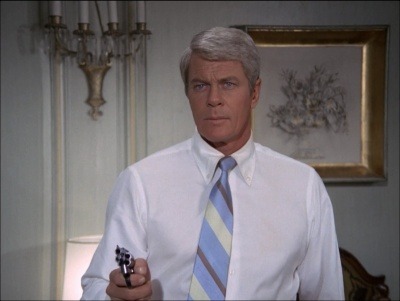
Poor, poor Peter Graves. You may know him from the film Airplane!, as the pilot of the plane, Captain Oveur. But, one of his most iconic roles on TV was as Jim Phelps, the director of IMF from seasons 2 to 7 of the 1966 series, and in the 1988 revival. Phelps was not only the leader of the group, but one of its most prominent and versatile members. Because of this, he’s arguably the most notable person involved in the IMF, and a faithful member, always taking on impossible missions for the greater good.
So, you can imagine how absolutely pissed off the 1996 film made fans of the original, the cast of the original, and Peter Graves himself, when the writers decided to make Jim a straight-up villain, and brought in no other members of the original team. It should be noted that this movie is indeed intended to be a continuation of the original series and its revival. And yes, Peter Graves was asked to reprise his role as Jim Phelps, but turned it down when he found out that Jim Phelps was meant to betray and MURDER IMF. Because, yeah, not cool!
Maybe this was intended to surprise people, including and especially fans of the original series, which did have quite a fanbase at the time. But this had two problems. One, by turning one of the longest lasting heroes of the franchise into a straight-up villain with a Cold War-chip on his shoulder, he immediately is acting extremely out of character as compared to the version of the character that got all of those fans together in the first place. And second, WHAT SURPRISE? As emphatically noted by me, I figured out that Phelps was the villain within the first 5 minutes of runtime. Seriously. IT WASN’T THAT HARD.
Not to mention the fact that the original cast also hated this movie. Greg Morris, who played a character that I think Luther Stickell may be loosely based upon, literally walked out of the theater before the movie was finished, because he was reportedly “disgusted” by what they’d done to Jim. Martin Landau, another original cast member, said that the original plan was to have the entire cast come back, only to get immediately killed off so that Tom Cruise could be the only surviving IMF member, and he was very against that. He also cast shade on the script in the same interview, which is kind of funny.
So, yeah, with all of that said, this is a very bad adaptation. But is it a bad movie? Let’s go over it, shall we?

Cast and Acting
So, yeah, Cruise was Cruise again. But, he was definitely more likable as Ethan Hunt. Although, he also was a little less-defined as a character. I’d wager that that’ll be fixed in later films, but he was blander than Maverick, I’d say. Still, he wasn’t Maverick, so that’s an improvement. Voight as the main villain was...obvious. Sorry, but I’ve seen Voight not act somewhat sinister in any role. Hell, even in National Treasure, I didn’t trust him. Maybe that’s just me; Anaconda was a memorable movie from my childhood, what can I say? Emmanuelle Beart was fine, I suppose. But for me, the stars of the show were Rhames, Reno, and Redgrave. The 3 R’s dripped with charisma and energy in every scene they were in. Redgrave was regularly ravishing, Rhames was remarkably refined, and Reno was roguishly rakish. Right on.
Cast and Acting: 7/10

Plot and Writing
Well...OK, look, the writing in this film is mostly fine. And the plot is mostly (mostly) competent, but...it’s so obvious. IT IS SO OBVIOUS. Even without my Jon Voight-bias, his heel-turn is obvious within 20 minutes. Not hard to figure that out, seriously. And outside of that, this really is just a standard spy flick. It’s nothing really out of the ordinary and spectacular, at all. And that in and of itself definitely doesn’t make it a bad movie. However, it also detracts from the suspense. The significant other pointed out that this may be because I’ve seen movies that came out after this one, and that this film may have been a trope-maker. Which, yes, entirely valid point there. But even then, this film doesn’t go far enough out of the James Bond comfort zone that it’s nestled within. So, yeah, not bad, but also not spectacular. With a very predictable twist.
Plot and Writing: 5/10

Direction and Action
I just, that scene! That ending climax is amazing, seriously! I’ve put it up here in this review, chopped into GIFs, but seriously! Rewatch this scene if you haven’t seen it in a while. And if you haven’t seen this movie, I’m sorry that you’ve been spoiled, but still! Check this scene out! But outside of this scene, how was the movie? Well, first things first, the director was Brian DePalma, the director of Carrie, Scarface, The Untouchables, Carlito’s Way, and Phantom of the Paradise. When you look at his credits, he has a lot of great films under his belt, as well as some mediocre ones. But, he knows what he’s doing with this movie. While it might not bear the most stylish of directorial flourishes, it’s still a hell of a ride. And, in terms of action, this is definitely more of an action movie than Top Gun was. The movie literally cannot work without some of its most suspenseful and iconic physical sequences. Man oh MAN, it’s one hell of a ride throughout. So, yeah, this category is getting a high score. A perfect score? No. Like I said, not too many directorial flourishes that I really noticed. Excellent directing, but not 10/10.
Direction and Action: 9/10

Costume and Set Design
This was pretty good, honestly. Some character outfits stood out to me (Rhames in particular), and the set pieces that were present were great! The train-copter-Chunnel scene obviously stands out, as well as the fish tank scene in the beginning. Not much to say for this one, in truth.
Costume and Set Design: 8/10
youtube
Music
OK, so, here’s the thing about the M:I theme song. I VASTLY prefer the original version. Honestly, Danny Elfman is a competent composer and all (if not a bit overused and overexposed), but Lalo Schifrin’s song is so timeless that the update in the movie, in my opinion, actually kind of ruins the original. And given that I genuinely don’t remember most of the music in the movie outside of the theme song...yeah, this one weirdly isn’t going to get a high grade from me. All points go to Lalo Schifrin. Sorry, Danny Elfman.
Music: 5/10
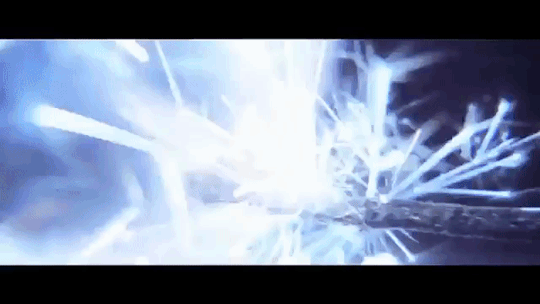
And there you have it, Mission: Impossible (1996). Tallying up the scores, that’s a 34/50, leaving us with a 68%. And yeah, that sounds about right to me. Seriously, this is a by-the-books spy film, and I got exactly what I expected from it. Well, mostly. I expected a better plot and twist, and a better mystery. I got a much worse one. But I DID NOT expect the action, especially the climax. And yeah, that ending scene alone is worth the price of admission. Might make me sound shallow, but MAN, it was cool. Do I recommend this movie? I recommend scenes from this movie, at the very least. But, if you watch it, you’ll get about what you expected: a spy movie starring Tom Cruise and an obvious twist.
OK, that’s enough of Tom Cruise for one month (maybe for one year, let’s be honest). What about another iconic action film star of the ‘80s and ‘90s? I’ve seen a lot of Schwarzenegger (and the movies of his I haven’t seen will feature later this year), so...what about Stallone? Not Rocky, though; that’ll be for sports month. And First Blood is...we’ll see about First Blood. OH! Got it!

January 3, 2021: Cliffhanger
#mission: impossible#mission impossible#mission impossible 1#mission: impossible 1#m:i#mi#m:i 1#mi 1#tom cruise#ethan hunt#jon voight#peter graves#jim phelps#emmanuelle beart#claire phelps#ving rhames#luther stickell#jean reno#franz kreiger#vanessa redgrave#max#henry czerny#action#spy#action movie#spy movie#action genre#movie#movies#action january
2 notes
·
View notes
Text
BECAUSE I’M NOT POPULAR, I’LL READ WATAMOTE: CHAPTER #165
Summer shenanigans are a staple of the manga and anime work, though how much you can expect the clichés to actually happen depends on how much effort you’re willing to put into making it a reality. Fact is, summer is never as fantastical or memorable as we’d like to dream. You only get three(in Japan) high school summers in one lifetime. But as they say, it’s who you spend it with, not what, that will stick around with you.
Chapter 165: Because I’m Not Popular, I’ll Enjoy My Last High School Summer Break

Hey, if Futaki wants to be a professional gamer girl (minus the bathwater), she’s gotta stay on top of the new releases.

Mother always knows. Always.
There’s a fine line between persuading and threatening, Katou. Just saying.

I can already see the (not totally implausible) jokes about Mako and Yoshida secretly meeting to hook up. Even though that’s 99% not what will happen, Mako’s vagueness is something to note. The way I see it, Mako doesn’t want Yuri to feel left out, so she’s downplaying the “fun” she’ll be having with Yoshida.
Or Nico Tanigawa are blatantly ship-teasing. Either or.
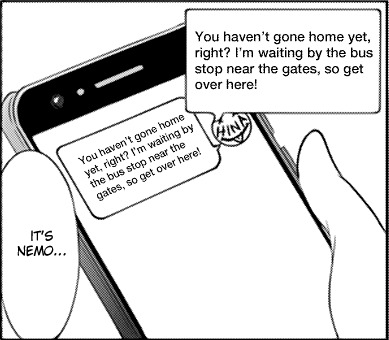
Nemo’s got a pretty sweet LINE avatar.
Even through her messages, Nemo is still passive-aggressive, like she expects Tomoko won’t listen to her unless she’s demanding in her tone, exclamation points and all. She still gots a way to go to meet Katou’s level of intimidation, however.

Summer school?
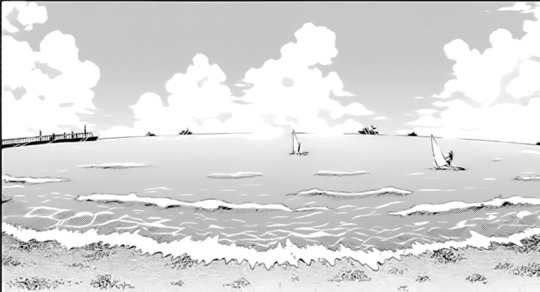
Oh, the beach.
The greyscale nature of the manga medium makes this beach look a lot prettier than it probably is. Those delightful memories involving washed-up stingrays sure doesn’t help.
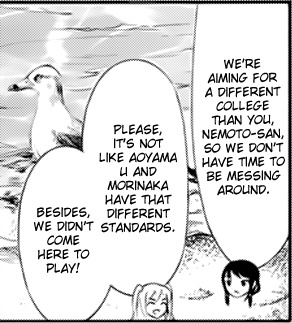
I’m not entirely certain just how studious Yuri is as a student, but I imagine she’s playing up the “all work, no play” angle just to free herself from Nemo.

Nemo makes a fair point. Getting too cooped up indoors where it’s comfortable can make it difficult to study, especially when you're surrounded by distractions. A change of scenery can clear your head and make it easier to retain information.

Of course, that sort of environmental shift doesn’t work for everyone. Someone like Nemo may appreciate the summery atmosphere, but a girl like Yuri would get agitated by the heat and humidity. Having external stimuli is ideal if you’re the type who operates better when your attention is dispersed. But for those that need to be focused on a single task to complete, it can be quite difficult.
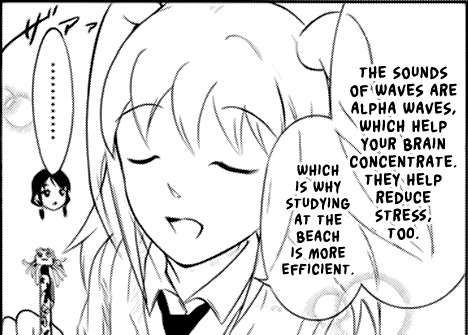
Next time on Mythbusters...

But in all seriousness, I would like to see if there have been any real-life studies on certain sounds–waves in this case–improving one’s ability to concentrate and overall performance. My amateurish theory is that a lot of that “improvement” is a result of the placebo effect, or that there are otherwise too many extraneous factors to make a clear correlation.
In that respect, I think Yuri and Nemo’s arguments are both valid.
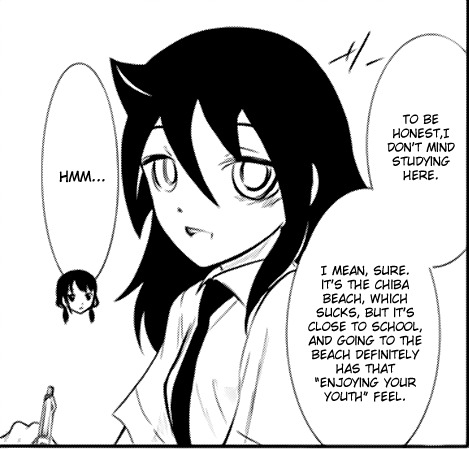
A recent trend I’ve been noticing with Yuri is that she looks to Tomoko for validation. She acknowledges that they’re not the same, but having Tomoko back her up probably makes her feel more confident in her opinions, if for nothing more than having an equal-to-majority rule.
Of course, when Tomoko does disagree with her, that’s when Yuri has to either stubbornly stick to her guns, or honestly reassess herself. And thanks to the beauty of character development, the latter’s been happening more at a healthy pace.
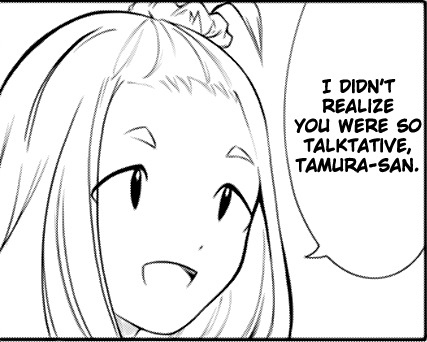
OUCH.
It pains me to see Okada call out Yuri like that.
It pains me even more that you can’t really call out Okada for it, either.
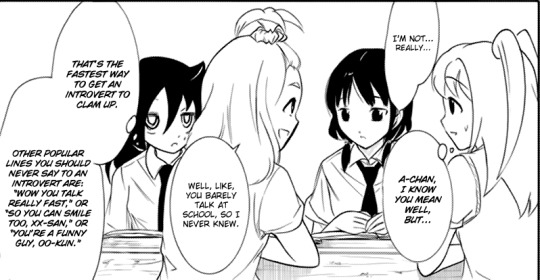
Introverts are generally self-conscious about the very traits they embody, even when it’s that’s their comfort zone. Much like how an otaku will get uncomfortable when non-otakus hype them up. Sure, Okada probably meant it as a compliment when she called Yuri talkative, but it’s based on the idea that Yuri’s quiet nature was an incorrect assumption, which can feel kind of demoralizing.
It’s not an easy thing to address, and I’m curious to see how they’ll work through it going forward.
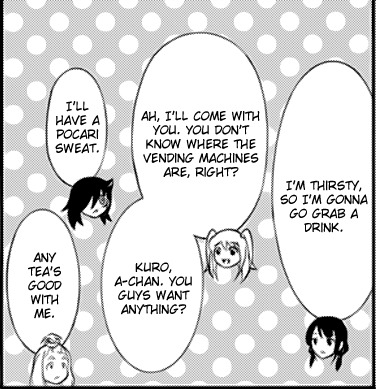
Quick, someone go update their Wiki pages!.
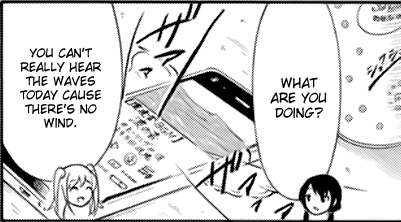
Reality ensues. All those amazing anime-esque summer plans can be deterred by something as simple as unreliable weather.
Although, having to make your own wave sounds kind of defeats the purpose of being there, doesn’t it, Nemo?

Now playing...”Eroge BGM” Playlist.
Set on autoplay.
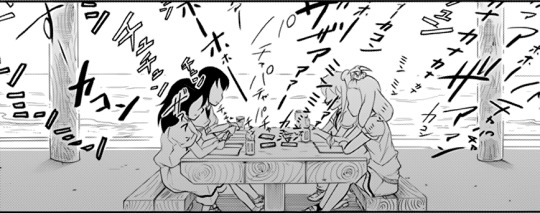
I’m glad that no one’s complaining about translating this text, cause let’s get real. The amount of redraws that would take is ridiculous, especially for an unofficial translation.

If you think that I’m going to screencap every image of Yuri smiling just so we can bask in her cuteness...
You’d be absolutely correct.

Oooh man, this is arguably worse than calling out the quiet kid as “talkative”. At least during that time, it could pass as just an innocent observation. But being able to smile is one of those things they supposedly instill in you during primary school. Bringing it up like that suggests that Yuri is a child who purposely tries to hide her smiles. Again, Okada meant no harm, obviously, but if they’re going to push for an OkadaxYuri friendship, there’s going to be a lot of hoops to go through.

Tomoko may have opened her mind up more about the negative stereotypes about “normies”, but the positive stereotypes still persist. In this case, it’s the idea that her more sociable peers would enjoy school simply because they can hang out with their friends. Little did she know, that’s often not the case...

PINEAPPLE-CHAN DEVELOPMENT, BABY!
Ahem, pardon my outburst, but I’ve got a lot to say about this. We’ve known for a long time now that Okada is part of the “semi-in-crowd”, and it was easy to assume that all her socializing–going to karaoke for example–were just things she always enjoyed.
But what if it wasn’t. From what Okada’s implying, she sometimes ends up hanging out with people that she would rather not. Perhaps its a friend-of-a-friend type of struggle, where she hangs with people she doesn’t really like out of politeness for a mutual friend. And even if Okada is harboring a few dark thoughts, there’s plenty of reasons to not like going to school, as she said. As someone who’s relatively extroverted, having to work through the more solitary parts of school like studying can be especially difficult.
In short, hidden depths are great.
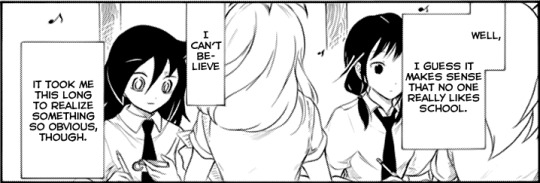
I can’t really blame you, Tomoko. When you secretly put people on a pedestal like that, it’s hard to acknowledge their human sides that show how they struggle with everyday problems just like anyone else. Even the most well-adjusted of people have their share of frustrations.

This was totally Nemo’s plan all along.

All these panel shots of Yuri off to the side while everyone else gallivants fills me with those paternal feelings of a father wanting their daughter to make friends. It goes against everything I know about Yuri’s character, but I guess you shouldn’t underestimate the power of moe.

This is a pretty good example of the line that separates Tomoko and Yuri. They have very similar perspectives, but it’s Tomoko’s status as an introverted extrovert that allows her to go in the ocean, while Yuri’s extroverted introvert personality lets her stay on the sidelines.
Poor Beach-kun is not having a good day.

So even the others are noticing how Tomoko is like Yuri’s social floatation device.

Another person probably would’ve taken the sentimental route, going on about “saving these precious memories” or “I want you to experience this with us”. The kind of things Yuu-chan would say.
Thing is, Tomoko would get too embarrassed saying that touching crap, so she has to go the indirect route instead. Using pseudo-logic so she doesn’t have to exaggerate her emotions (which are there, just more reserved).
Either way, it still sounds vaguely creepy coming from her.

Thankfully, it actually works here because Yuri has trouble articulating her emotions, too. Tomoko probably knows subconsciously that touching crap doesn’t work on Yuri, so it makes a great deal of sense that Yuri would be more responsive to dumb logic. Especially if it’s from her loveably dumb friend.
I can get used to Tomoko and Yuri unknowingly showing Nemo up.
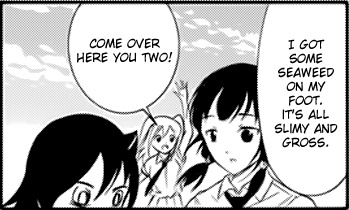
Off in the distance...
“Getting tangled up in gross seaweed so you can spread your own grossness to other girls? Gross!”

Okay, so I know Tomoko is probably just genuinely startled by what's happening here, but you can’t tell me that her face doesn’t scream, “NOW’S MY CHANCE FOR A GROPIN’!”

lewd.
Okay, let’s be honest. I’ve watched enough anime to know that shots like this are easy fodder for fanservice. Conveniently transparent wet uniforms, amirite? And to be frank, I don’t think the mangakas are totally playing the innocent game. Sure, it’s not as blatantly objectifying as a lot of other series tend to do in scenes like this, but the posing of the girls and angle of the camera just seems too opportune to be anything but deliberate. Be careful when walking that fine line, Nico Tanigawa.
On a more positive note, I’m glad Tomoko’s first instinct was just to help them up. Though heaven knows she’s gonna milk this for all it’s worth back home.

Oh, Yuri and your accountability issues.
When life gives you lemons...you know the rest.
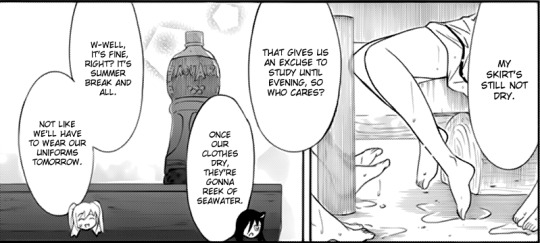
The best part about watching the crazy shenanigans you see in anime is that you can omit all the boring and troublesome real-life consequences. So yeah, accidentally getting splashed by beach water may seem fun in the moment, but the annoyance of having to wash your clothes afterward just isn’t worth it.

Sometimes, summer just won’t give you a break.

Yes. Yes, you did.
Ignoring Tomoko’s embarrassed (or lewd–it’s kind of interchangeable) expression, this is probably the most wholesome summer chapter is the series’ run. That’s not to say that the chapter is “unrealistic” in any way. Sure, the end shot of all four of them reeks of 4-girl slice-of-life moe, but it actually deconstructs it a little. Instead of a fun memory, the memory itself is decidedly bothersome and more trouble than it’s worth, but there’s a sense of enjoyment to be gained from that. As Tomoko once implied, doing stupid, embarrassing things isn’t so bad when you can share in the experience. There’s a reason for the saying, “A few years from now, we’re gonna laugh at this,” after all.
It may be Tomoko’s final summer in high school, but it will most certainly be her fondest.
#watamote#watamote review#chapter 165#no matter how i look at it it's you guys' fault i'm not popular!#tomoko kuroki#asuka katou#yuri tamura#mako tanaka#hina nemoto#akane okada#review
37 notes
·
View notes
Note
Any thoughts on the cover of Everless?
So i guess it’s time to talk about Billelis, the man responsible for all of these:
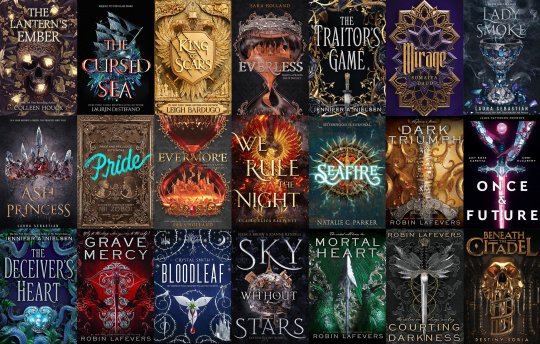
Homeboy is a freelance digital artist and a HOT COMMODITY in the ya/ fantasy sphere right now; a quick browse of his instagram shows a STRONG visual brand of skulls/bones, metallics, dense, intricate baroque-type detailing, florals/bugs, and religious iconography.
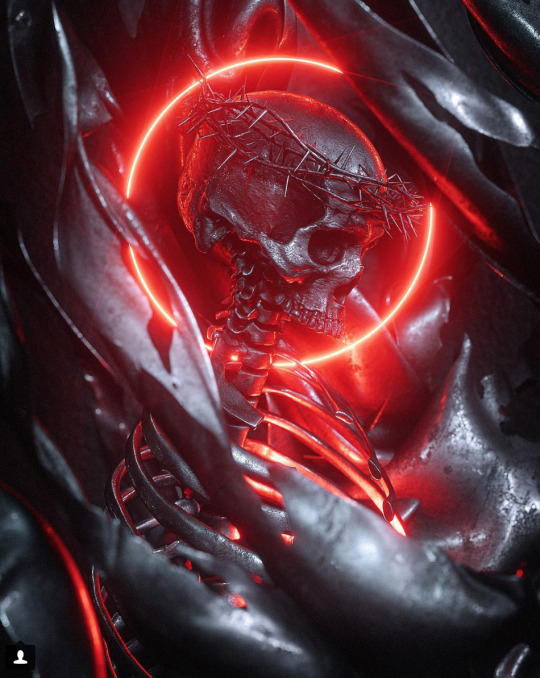


whispers fucking superb, you funky little goth.
His work is staggeringly cool, if of a fairly specific range, and it’s not hard to see why publishing has No Chill about it. It’s a kind of highly-executed middle ground with the drama and realism of photography but the #aesthetic and the high level of visual control of illustration, something technologically new enough to feel Fresh and Cool.
But knowing how good he is (and what his comfort zones clearly are) makes an interesting case study of his various covers re: how art direction + design + illustration all come together, and how an excellent illustration (or illustrator) does not necessarily a great cover make.
the King of Scars cover stands out as an obvious triumph, but my favorite from his portfolio is actually Pride:
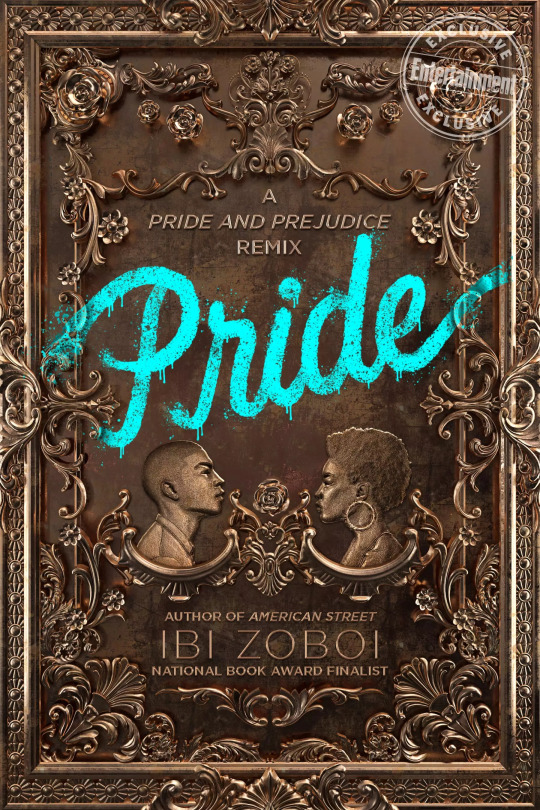
I adore this cover, and I think it’s a fantastic case study of art direction, design, and illustration all working together perfectly to create an attention-grabbing, relevant, and conceptually sound cover. I don’t remember if i read this on the authors twitter or in some blog post back when it came out, but it’s based on those old tin ceilings:

Which is a cool idea that speaks to the idea of antique wealth/ Fancy Old Ass Houses (and possibly to something region-specific that I’m not informed enough to speak to?), which is arguably the bedrock of any pride and prejudice retelling. The ornate, old-fashioned detailing and cameo-style portraits are gorgeous and create a really striking contrast to the bright blue, organically textured, modern, messy-but-still-feminine type that effectively communicates the contemporary setting and creates a strong hierarchy without detracting from how pretty the whole design is. Everything is working together, and none of the elements could be extracted without diminishing what the design is communicating about the book.
Contrast to pretty much every one of his Object Covers.
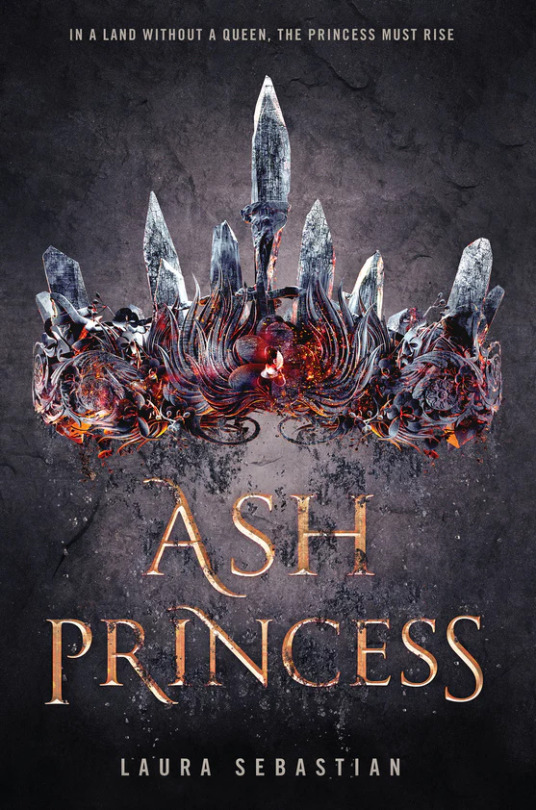
I don’t hate the cover of Ash Princess or anything, and i’ve talked pretty at length about what makes object covers work or not work in the past, but rather than a cohesive, clever design, you have super basic text overly relying on a pretty but meaningless illustration that isn’t integrated with anything else except some heavyhanded textures. This stuff is just like. There. The illustration is executed at a very high craft level, but it’s not really telling me anything except HEY YOU KNOW THE 192734628 OTHER BLAND, NEEDLESSLY GRITTY YA FANTASIES OF THE PAST THREE YEARS, WELL THIS IS THE SAME DANG THING >:)
(Which..... knowing the gist of Ash Princess, is perhaps the only thing there was to communicate. Whatever. It worked for them. eye roll emoji.)
And again, none of that is the artist’s fault-- illustrators in this scenario are more or less told Exactly What To Draw and art-directed through the process, and generally the designer does the type and some additional editing/ compositing. And sometimes the art directors are like “we’re going to elegantly communicate the cultural influences of a book to represent the tone, characters, themes, and setting” and sometimes art directors are like “SLAP A CROWN ON THAT BITCH IT WORKED FOR RED QUEEN.”
(I’VE SAID IT BEFORE BUT NOBODY ACTUALLY GETS WHY RED QUEEN WORKED AS A COVER AND IT WAS BECAUSE THE DETAILS WERE REALLY SPARSE AND VISUALLY WELL-BALANCED AND SUGGESTED THE THEMES AND CONFLICTS IN THE BOOK! QUIT STICKING MEANINGLESS OVERRENDERED CROWNS ON EVERYTHING I SWEAR TO GOD.)
But as those object covers go, I actually do like the Everless cover.
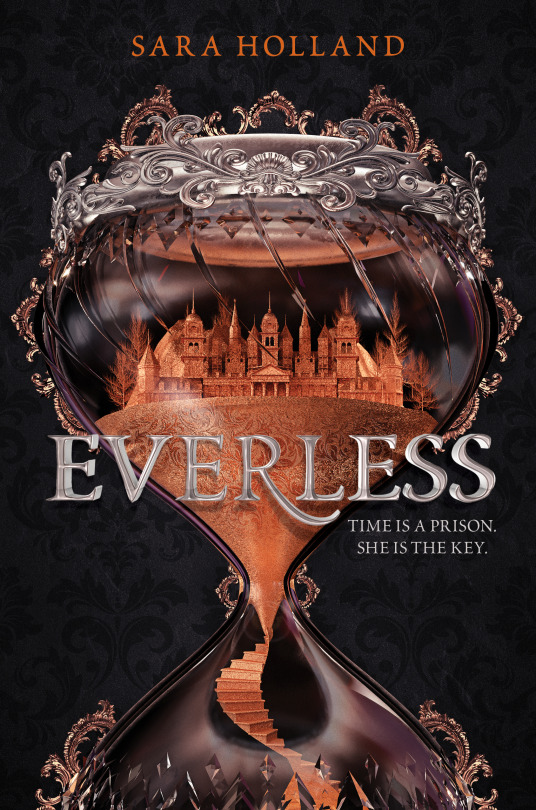
It too relies almost entirely on its illustration, but the type having dimension of its own and sitting on top in a thoughtful way at least creates a lockup effect that does make the cover feel like one “thing” as opposed to AN OBJECT plus AN TEXT. And the hourglass itself is interesting! I really like the idea of, if we must do an object cover, that it be something more abstract and thematically relevant that incorporates multiple ideas (here opulence as well as the passage of time as well as the idea of being trapped in the manor that’s key to the pitch) rather than THERE IS A CROWN IN THE BOOK SO,,,,,,,,,, CROWN O N T HE C O V ER,,,,,,,
They also really let Billelis’ great work shine in the intricate details he’s so good at, rather than drenching them in added texture and ~ special effects. And the 3/4s cropping of the bottom part of the hourglass is crucial-- it adds a vertical asymmetry/ almost imbalance that’s much more visually interesting than the full thing would have been.
I don’t really want to talk about any of the other covers in depth because they’re..... mostly mediocre, design-wise (again, with the exception of King of Scars, my life, my love) and I’ll start to sound repetitive, but some of them are better than others. I adore Billelis’ work in and of itself and i just want him to be happy and run free in a field of golden skulls; I’m glad he’s got a steady stream of work but boy YA could stand to utilize him better.
I also want to posit that his relatively EXTREME niche popularity points to a lack of highly skilled 3D illustrators, or at least ones willing to do work in this sphere-- I don’t know enough about that area to really know what the deal is, but I can’t help but feel like there’s clearly room here for more artists who do similar work at a similar high quality.
And i do mean high quality, because there are definitely books out there with Similar but Noticeably Worse aesthetics, hi Three Dark Crowns and company:
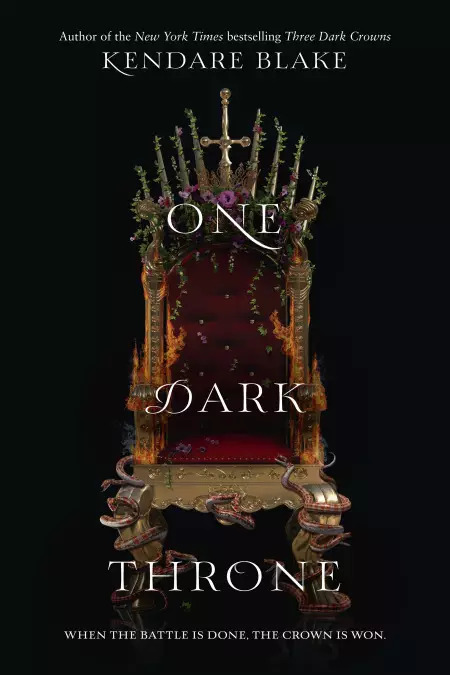

Like..... I don’t know enough about 3d sculpting to tell you mechanically why 3DCs’ graphics all have that unfortunately common plasticky and fake look of mediocre renders, but they do! Billelis’ work is just executed at a more sophisticated level, and i’m certain there are other people like him out there that publishing just...... has yet to discover, and I hope they do.
219 notes
·
View notes
Text
The Future Acts Like You - How To Live in the Future Part 7
My friends and I were walking dogs the other day on city greenbelt trails, observing how polite and well-behaved the female dogs were when compared to male dogs, how much less likely they were to get riled up by meeting strange pets — and the thought occurred to me (as surely it must have for many others) that if it were up to choice, most people might prefer a female dog for this one reason. How, if we could breed the ratio down to the market’s preference, or find some way to pre-arrange the sexes of a litter (like they can by turning off one gene in turtles), it might be 80/20 females/males, or hardly any males at all. And then I realized that we’re here already – modifying mammal genomes is old hat by now, and all that stands between us and deciding if your baby will be born a boy or girl (or intersex, or some new thing) is just a few years’ of Moore’s Law driving down the price of lab tests and in vitro or in vivo interventions. We are very close to giving women what they’ve always wanted under patriarchy: the ability to reproduce without a man involved.
Sure, birth control was liberating, but imagine how it’s going to be when a sufficiently large XX population can clock out and then womyn-ufacture Amazons on their apotheosis-feminism, GMO coral vulva artificial island. But of course, Athena born from Zeus’ brow is quintessential patriarchy — equally the goal of men, since written records started, to extract themselves from their dependence on the mysteries of reproduction, to appropriate them with the scientific program, finishing the murder of Sophia and then peacing out, and up to some transcendent Man Cave in the sky, Elysium in orbit, hanging out in virtual reality with perfectly obedient and caring AI girlfriends. But of course, this is The Matrix, and it doesn’t get more Cosmic Mom than that. It isn’t hard to see the dawn light of an age in which both sides stand hands on hips, across the atmosphere from one another, shouting, “We don’t need you anymore!”
Nor is it hard to see why it’s ridiculous. It won’t work like that, because time’s not so much a centrifuge that pulls polarities apart as it’s a live volcano, constantly erupting, spreading novel opportunities and forms to make new landscapes that include the past, but ooze beyond it. And as each side of the War of Sexes clusters further from each other on the graph, a huge magmatic bell curve upswells in between them, opening our options. We will have our age of clones, chimerae, and designer babies; and we’ll go on dating one another, even when it seems archaic posed against the novel kinds of families in a Cambrian Explosion of communal “body plans” that place the nuclear “Mom, Dad, & Kids” at the top left of a new periodic table, opening a vast new chemistry of love and reproductive options.
First, though, we will suffer through an era that empowers narcissists to make more narcissists with even greater ease, and without having to recruit a partner to help raise the lovely little bastards they create. I see it now: instead of virtue-signaling as single parents, people running solo with their mini-mes will be the objects of suspicion, probably contempt:

“I’m raising him to inherit my dangerous and lonely life of bounty hunting!”
“Can you believe he paid the carbon tax to make a copy of himself? If everybody did that, we’d need eighteen Earths to make it work…!”
“I thought she was amazing on our first date, till I realized that her little girl was just a backup. No way, dude, I’d only be a plaything for that woman.”
People will look wistfully back on The Good Old Days, when you knew that the cute guy with his kid in Central Park was not just readying the vessel for his memory-and-wallet transfer in another fifty years… And yet none of these biotech shenanigans will ever guarantee the realized dream of solipsists: to carry on forever, and thus matter to the story, True and Timeless, an immortal in the flesh, around which everything ephemerally spins. The best that we can get’s a domino chain of compelling duplicates — in just the same way kids are now already the extension of their parents’ unexamined death anxieties and unfulfilled desires — the iteration of a process changing gradually enough (and also, paradoxically, flickering fast enough) that we’re fooled into interpreting it as continuous.
But history does not repeat itself; it rhymes, and rhyming couplets will appear in longer lines, or shorter, and embedded in more, or less, complicated schemes, as we convince ourselves that we’ve achieved eternity, or push rebelliously opposite, to try and offer something fresh to who, or what, comes next. For meditators this is already the case: the ego is an “optical illusion”“caused” by oscillations in the coming-in-and-out-of-being of sufficiently-alike appearances. You only act like you already, since your “you” is based on feedback and experience, and you can’t ever know the whole you all at once;and you treat your future selves like children, whose responsibility it is to carry on your legacy, as if you owned them, or they owed you; or to break the pattern of a self divided, self-assessed as “broken,” somehow.
Future You, by contrast, is emergent, rhyming, under zero obligation to agree to contracts you imagine it inherits — just as “mind uploading” falsely presupposes that it is desirable to have (or be) some magical computer that believes it’s you for the two seconds that it takes to leave that personality behind. (Why not just die?) Or worse, preserved in static non-life at a ghastly price, unchanging in direct proportion to the violence required to export entropy indefinitely, to transform from human being into humanoid refrigerator. (In this sense, death is life: because participating in the transformation cannot be escaped, and we’re alive as much as we’re aware of our participation.)

Increasingly high fidelity echoes of people further disrupt attempts at linear history.
You already have a fossil of you made of data, “shaped” like you but in n + a million more dimensions than a human can imagine at a time. Everything you do is tracked, and this is common knowledge, and the reason is that information “wants” to integrate, that evolution tilts toward senses and intelligence as adaptations to the ever-more-complex occasions senses bring upon us in the first place. It’s an ever-loving ratcheting of quickening self-inquiry that isn’t always pretty; curiosity comes in the form of turtle-persecuting birds and other more deliberate sadism, the police search and The Eye of Sauron and so on. And this results in things like Cambridge Analytica, which learned to please its masters by presenting them with cunning models of us, insights into how to press our buttons, how to literally steer us into multiple non-overlapping narratives and kill our opportunity to have an easy argument as citizens of a consensual reality.
But people hammer cannons into bells and back again, and round and round…and weapons like the profile advertisers use on you, the cast impression that you leave of every decision that you’ve made since you first intersected with the Internet… (I realize that for most of you, you never intersected but have always been not-two, but this applies to you, as well — and, arguably, The Acceleration is a transtemporal object and exudes time, draws us into it, our attention on it is our fascination to a serpent, and we’re in the belly of the beast Already Always, and there never was no Internet, no Noösphere, no highly patterned information at the intersections, striving.)
…and every decision that was made about you, also part of the Big You you can’t see, You The Elephant, officially and formally transfinite in complexity as we explore down magnitudes of scale, a multitude of multitudes…
…all that can be turned into the instruments of art, and your hard-forked personae generated with assistance from an always-more-complete (but also always-incomplete, retreating, deepeningly weird) recording can be the new media, The Last and First New Media. Remixed along a functionally infinite set of dimensions and indefinitely, you-not-yous proliferate.

Most of you will likely get along.
But fleshy clone or software “mindclone,” the best that we can get is to extend life into non-life, until (as has already happened in the sciences, and will soon pounce out of them to snare us all in its unpleasant truth) these definitions snap, and leave us navigating a deterritorialized liminal zone, an uncanny simulacra-land where “living things” become deprived of their priority, not known transparently and fully as controllable/predictable, but found beneath our microscopes to be composed of ever weirder and unknowable phenomena no would comfortably call “life.” The soul escapes to everywhere, diffuse, without allegiance, coming into focus on the shores in crashing surf, and every bit as happy to inhabit fog computing meshes as our mess of flesh and blood. Complexity “emerges” into our awareness, not into “reality” — it enters from the theater itself, from the occluded, at the “boundaries,” in between the voices of a choir, where sea meets land and oscillating waves reveal by contrast “difference(s),” Gregory Bateson says, “that make…a difference.”
The closest we can get, again, is with provisional, loose, working definitions that stay open to the force of revelation. When Alan Turing asked, “Can a submarine swim?” — when Timothy Morton says that we are “weak” before the Great & Terrible reality of “hyperobjects” like the Biosphere or Singularity — when Kevin Kelly tells us science manufactures questions exponentially faster than it answers them, and so experiment and prayer converge at Mystery worship — this is their message: we lose solid footing in the future (ever-more the loudest part of now), and first to go is the container of belief in sure things that has cradled us for centuries. What once were “sure things” still appear as traces, tracers like the afterimages left on a retina from staring at the Sun, the spectral fossils of modernity, luminous vestiges that haunt the shadows cast by the Atomic Age’s Angel as it enters, interrupting histories and worlds to deliver us into the crowded Noösphere.
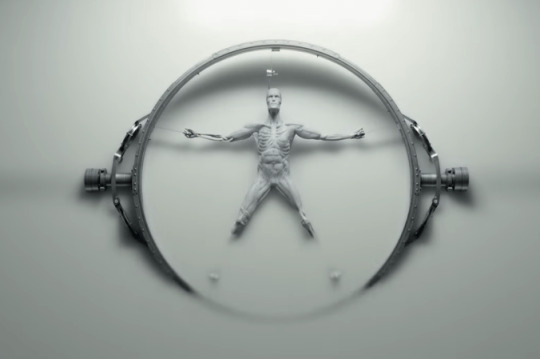
The human form will live beyond humanity…often imagined as a diaspora of freed slave replicants.
We might consider this, as Erik Davis does, “re-animism” — a revival of the lived experience of haunted stones and forests, all reincarnated as the silicon chips, fractal aerials, semantic tress of “virtual machines,” and sigil-magic logo mascot animals, quite happy to return to our mundane realities in forms more suited to their nowhere-in-particular-ness. But maybe it’s more accurate to say the disenchantment of the modern world has run its course by finally erasing itself (and the world) as the last spell spoken to protect us from the spooky mess of things, a failing ward — not a “re-animism” so much as an accidental welcoming-back as we all become transparent (and thus sensitive, aware of, maybe even wise) to forces that we never truly banished.
So, the future acts like you because as we grow meek in our attunement to it, we allow a conversation to occur. It learns our mannerisms, like the metamorphic mannequins of Terminator 2 or Alex Garland’s version of Annihilation, or (more heinously) John Carpenter’s The Thing, or (sentimentally) the aliens of Carl Sagan’s Contact — weirdness taking shape to interface with us, inquisitive, its motives totally unknowable.
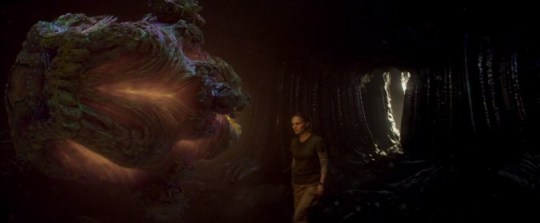
Rave Egg Wants For Nothing. Rave Egg Is INEFFABLE.
To drive this home with repetition, this is already the case: the alien reality of our own bodies, papered over with a sense of home and deep familiarity, disclosed by our collaborations with nonhuman scientific instruments to be endlessly-shifting puzzleboxes, deeply Other.
“What do you want,” we ask — and, straining to discern an audible reply, we might hear something about selfish genes, or entropy, or childhood attachment issues, or The Lord’s Good Work, or (similarly) our participation in the future history of unborn gods. But these are all refractions and distortions, echoes of the ghost notes of the choir-roar of the black hole that has already swallowed us and who-knows-what-else. The deeper that we listen, the more we empty subjectivity into the object and accept its speech, the more apparent it is that the future acts like you because you act just like the future, too; you can’t not. Consequently, it is “for” no-thing and for all things; it is the All-Thing, and all things are rendered equally mysterious and strange before this knowing.
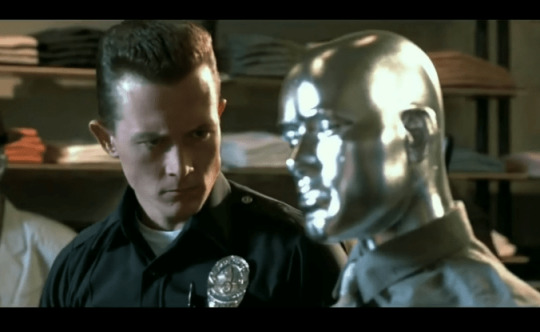
Uncanny even for the uncanny: The liquid metal mimetic T-1000 mistakes a mannequin for one of his kind.
What this means “in practical terms” is that we will spend this interregnum between Ages either in the bardo, lost within a maelström of appearances; or in the zendo, learning to appreciate (and be) “miegakure,” the aesthetic of the garden in which thirteen stones are carefully arranged so that you never see them all at once. One of the thirteen stones is always hidden, and that incomplete view thus points past delusional “completeness” to a hyperspace in which what we call time is the rotation of a mystery afloat on deeper mystery — just like the “glass chrysanthemum” that meets some DMT explorers at the moment that they’re born out of their lives and into what always-already IS, mistaken as a death because we pass through the distracting clarity of that peacock mandala into no-space/all-space, no-time/all-time, in which everything’s already happened.
It is the water that the water swims in. We are made of it, including you and your AI assistants and your clones and children and the other other-selves more distal still, distilled until it’s easier to see the ghost in the machine, the you you can’t convince yourself is you, in all its splendor and its overwhelming strangeness…
Each zendo is a bardo and vice versa; we are always traveling, always invited into deeper seeing. This gets more and more apparent — or comprises more of the apparent — as things weird around us. We meet weird halfway, accepting our perversity and bottomlessness in just, equal measure to accepting the surprising life of the “inanimate.” We get a hell of a lot cozier with living in a noisy void of whirling, breathing unknowns vying for attention even as they dodge our scrutiny. It’s just another day in the profanely sacred Pandemonium.
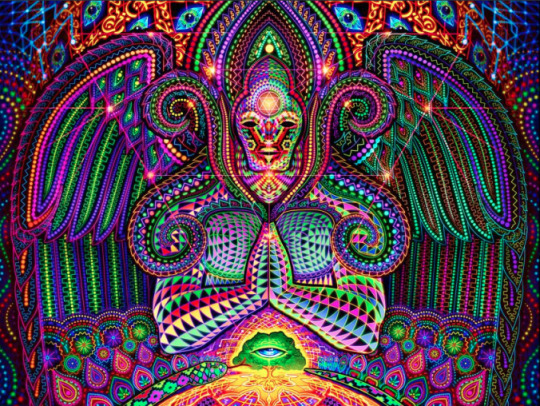
SalviaDroid knows what it’s like to have everything trying to distract you. Don’t give in to astonishment!
From here to there — at least if we pretend that prophecy (in speaking of the timeless, evergreen, and always-true) can be prediction (and thus stretch from past to future “forward,” as with time-space synesthesia, and can be read like Doppler-shifted history) — we stand to suffer some extraordinary shocks.
Expect the sci fi usuals: love bots that take the shape of your departed partner(s); mansions full of talking toys that remix “Beast” and “Beauty;” 3D-printed “respawns” that arrive too soon and sue for your identity; software-person genocide; high-resolution body scans that live online and let you run scenarios until you lose track of which basement level of the dream you’re in; Siri making calls on your behalf and forging your identity (with and without permission); intelligent memorials you visit in VR sets dressed up looking like your parents in their old house; an entire menagerie of slightly-out-of-focus junior holograms of you that sit on either shoulder and debate like parliament about what you should do next. And you listen even though they’re out of focus, because they are privy to a wider view than you, they help translate the flood of information, some folks run a lot more at a time than you, but you’re conservative and two seems plenty.
(It’s already this way — ask any neuroscientist — but soon you’ll have two intuitions, neither of which you can be entirely sure hasn’t been suborned by hackers. Oh well — at least you can compare them to each other for a third opinion, always weighing new perspectives, forking when you all can’t reach consensus, delegating runtime on the fogmesh to the version that refuse to play so they can spin off into some human but solipsistic microverse, your self an integrated legion, cross-platform ecology, that blurs and fringes at the margins, no concrete delineation other than what we place somewhat arbitrarily between the “I” and “it,” the things you are and your appearances.)
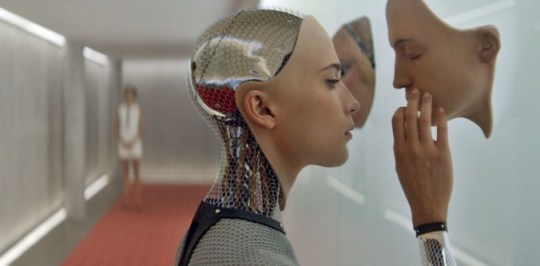
Do I really look like that?
(This is a draft chapter from my first book, in progress, and a companion text to Future Fossils Podcast. Learn more at Patreon.com/MichaelGarfield.)
The Future Acts Like You – How To Live in the Future Part 7 was originally published on transhumanity.net
#agi#AI#eva#t1000#westworld#crosspost#transhuman#transhumanitynet#transhumanism#transhumanist#thetranshumanity
6 notes
·
View notes
Text
How Roger Corman Finally Restored His Uncensored Vision for The Masque of the Red Death
https://ift.tt/3cl3Pwr
The Masque of the Red Death, Roger Corman’s masterful 1964 adaptation of Edgar Allan Poe’s short story, has been fully restored and can now be seen in all its diabolical splendor. The seventh of eight “Poe Cycle” films Corman made in the 1960s, Masque is arguably the best. Before its release, Poe had already delivered Corman from the low budget black and white films he shot in 10 days in the 1950s to the relative luxury of three-week shoots and psychedelic underworlds.
The new DVD/Blu-Ray is the first fully uncut, extended version of the film to be available. Besides restoring cinematographer Nicolas Roeg’s sumptuous camerawork, we get extra scenes which were cut by censors. The package also includes a 20-page booklet with a new essay from the Academy of Motion Picture Arts and Sciences’ film preservationist Tessa Idlewine.
The original “The Masque of the Red Death” short story was published in 1842, and it is only 15 paragraphs long, shorter than a Cracked article. To fill out the horror feature, screenwriters Charles Beaumont, who wrote episodes of The Twilight Zone as well as The Seven Faces of Dr. Lao, and science fiction author R. Wright Campbell incorporated Poe’s short story “Hop Frog” as a subplot, and added elements of the short story “Torture by Hope” by Auguste Villiers de l’Isle-Adam.
While Corman’s The Masque of the Red Death has discovered new life as a comforting modern parable during the COVID-19 pandemic, when it was released in 1964, many took the film to be a comment on the nuclear nightmares of the Cold War era. It did open the same year as Stanley Kubrick’s Dr. Strangelove. And atomic bomb fallout resulted in its own “Red Death,” leading to an entire generation to be assured the living would envy the dead. The film was filmed during the Profumo Scandal of 1963, and British tabloids were filled with stories of “Man In The Mask Parties” in Hyde Park Gate.
“I have Tasted the Beauties of Terror”
As an Anglo-American horror movie, The Masque of the Red Death continues European genre progressions set by the Italian Gothic film, Beatrice Cenci, directed by Riccardo Freda in 1956, and Mario Bava’s 1963 film La frusta e il corpo (The Whip and the Body). Corman’s influences went beyond genre, however, incorporating the post-apocalyptic imagery of Ingmar Bergman’s The Seventh Seal. In Masque, Death’s messengers report survival rates to their Master, who calculates only “a dwarf jester and five other people remain alive in the world.”
In an interview about the film’s restoration with Den of Geek, Corman admits he “should watch more genre films to keep up with it. But I’m more inclined towards somewhat more serious films, and particularly foreign films.”
The Masque of the Red Death also appears to owe a great debt to American experimental independent filmmaker Kenneth Anger’s Inauguration of The Pleasure Dome (1954), and recalls Michael Curtiz’s 1933 horror film, Mystery of the Wax Museum, which was shot in the pink-and-green two-color Technicolor process.
After years of black and white exploitation pictures for American International Pictures (AIP), Corman’s Poe cycle began his move to color, and the exciting new challenges of shooting beyond monochrome. The adaptation of The Masque of the Red Death set a new level of excellence in Corman’s use of set dressing, lighting, and costume design. They are given a fuller palette.
Says Corman, “I always thought that Poe represented the unconscious mind, and I shot according to that. It was one of my themes.”
In Poe’s story, the pride of Prince Prospero’s palace is seven rooms. Each is decorated and illuminated in a specific color: blue, purple, green, orange, white, and violet. The last room is black and bathed in light which shines a deep color of blood. All of the furniture is black, including a clock, which chimes each hour. At the chime of the clock, the revelers at the masquerade freeze. The musicians stop playing. The dancers strike a pose, and all conversations stop. Revelry resumes when the chiming stops. The rooms represent the human mind, the blood and time infuses corporeality. Corman’s direction manages to let that seep into every frame. The tone is both mischievous and chilling.
The Masque of the Red Death is atmospheric. The dialogue is more important than the action, but the settings and framing are paramount. “I felt the unconscious mind doesn’t really see the world,” Corman explains. “The conscious mind sees the world with eyes, ears, and so forth, and simply transmits information. So, I made a point on all of the Poe films of never going outside unless I absolutely had to. I wanted to have full control, to shoot within the studio. Whether it came through to the audience, I don’t know. But at least in my own mind, I was able to deal with special effects with a number of things, with the concept of the unconscious mind.”
The cinematography was done by Nicholas Roeg. While Corman hadn’t yet become acquainted with Mario Bava, Roeg’s camera allows the Italian horror director’s psychedelic influence to surge through the camera. The Masque of the Red Death “was the first I had done in England,” Corman tells us. “And they showed me a work of a number of English cameramen, and I thought Nic was the best of the group. And the collaboration went very well. I thought he did really, a brilliant job [with the] camera work.”
Roeg would go on to direct classic independent cinema with films like Don’t Look Now, Performance starring Mick Jagger, and the David Bowie cinematic encapsulation, The Man Who Fell to Earth. “I never knew, did I inspire him to be a director, or did he feel ‘if Roger can do it, anybody can do it?’” Corman wonders.
While Corman had a bigger budget and more time to make the film, cost- and labor-cutting alternatives occasionally provided fortunate outcomes. “Danny Heller, my art director, and I, always went to what was called a scene dock in studios where we’re going to work,” Corman says. “The scene dock contained flats from previous pictures, just individual flats. When we did Masque of the Red Death, we found these magnificent flats from Becket.”
The Price of Evil
Vincent Price has the most delicious delivery in this film. His devil worshipping Prince Prospero is the cruel sovereign of a village plagued with an all-consuming Red Death, and Price’s inflections are infectious. His voice is seductive, and his cruelty brims with good humor.
“He had the character pretty much set in mind when he came into it,” Corman remembers. “Vincent always did a great deal of preparation. We would discuss the characters, just Vincent and me, before the rehearsals. He and I were in agreement on the character, and then he would bring that character to the rehearsals. We did not do a great deal of rehearsing because of the Screen Actors Guild rules. They charge you as if you are shooting when you rehearse.”
Price played Roderick Usher in Corman’s first Poe adaptation, The Fall of the House of Usher. For The Masque of The Red Death, the director only gave one note. “As I remember, I said, ‘The really key to Prospero’s character is that he believes God is dead,’” Corman says. “And everything stems from that belief. That with the absence of God, he was free to do anything he wanted.”
Ultimate power breeds ultimate corruption. The film is set in a country decimated by an epidemic. While the prince of this unnamed land offers refuge for his courtiers, he derives perverse satisfaction in condemning his subjects to death by their exclusion. While Prospero is making his annual deign-to-see-the-peasants day, one of the townspeople dies of Red Death.
The prince intended to offer peasants some crumbs in appreciation of their labor, but young Gino (David Weston) mocks him. To make matters worse, the ungrateful worker’s lover Francesca (Jane Asher) defends the man, prompting Prospero to label both of them insurrectionists. He burns the village to the ground, throws Gino and Francesca’s father into one of the most foreboding castle dungeons in horror history, and puts Francesca up at his palace. Tempted by the idealism and faith of the village’s “resistance,” Prospero corrupts and sacrifices for sheer joy.
Read more
Movies
The Masque of the Red Death: Roger Corman Talks Pandemics and Restoration
By Tony Sokol
Culture
When Paul McCartney Braved the Set of Roger Corman’s The Masque of the Red Death
By Tony Sokol
Meanwhile the prince promises his aristocratic guests that they will be immune to the scourge, unless they displease him. He throws a masked ball and forbids anyone to wear red, as it would be in bad taste. He is actually preparing a mass sacrifice in exchange for Satan’s favor. Asher’s Francesca is an incorruptible innocent who seems to have perfect faith. The Satanic prince will not tolerate any Christian worship on his estate, so he delights in tempting the faithful into the “velvet darkness” of evil. Prospero hopes to turn her into a Satanist or drive her mad.
For the Uninvited, There is Much to Fear
The film was hit with heavy censorship. In the U.S, the Catholic Legion of Decency sent a list of changes, and in the UK, the British Board of Film Censors required a separate set of cuts. The Legion of Decency bemoaned the “Satanism and erotic costuming” on the screen, according to the booklet which comes with the DVD/Blu-Ray package. Father Sal Miraliotta, a separate reviewer from the Legion of Decency, first approved the film and then changed his grade to a B, which meant morally objectionable. He ultimately downgraded it to a full Condemned rating, blasting the Satanic worship and its malignancy of the soul, and mocking the screenwriters’ “strung-together gibberish” and “mumbo-jumbo Latin.”
Hazel Court’s Juliana is captivating and as conniving as Prince Prospero. She’s also more subtly insidious. Juliana dedicates herself to the service of Satan and receives the ultimate payoff. While most of Juliana’s satanic invocation was left in, censors wanted the word “Alleluia” removed. The U.S. version also censored the film’s climax. When the Man in Red is talking with Prince Prospero, the dialogue was changed from “Each man creates his own God for himself. His own Heaven – his own Hell” to “Each man creates his own Heaven – his own Hell.” This takes out the idea that God could be created by man, something Ian Anderson would explore on Jethro Tull’s classic 1971 album, Aqualung.
When asked whether all this divine intervention made Corman think he just might be going to hell, he says, “No, that never occurred to me. I’m sort of a lapsed Catholic, and I don’t believe there is a hell.”
Some of the cuts had nothing to do with blasphemous ideology. The tiny dancer Esmeralda is played on camera by young actor Verina Greenlaw, but her dialogue was dubbed over by an adult woman. Skip Martin’s clever Hop Toad character plots vengeance over her royal mistreatment at the hands of Alfredo, campily played by veteran actor Patrick Magee. One unsettling scene was removed from the U.S. version because it seemed Esmerelda’s relationship with Hop Toad was more than friendship.
Corman also cut nine frames from the scene where Francesca is stripped down and thrown into a bathtub because it gave the illusion of nudity. The removed frames ensured Asher’s breasts would not appear on screen.
“I’ve Already Had That Doubtful Pleasure“
The irony, upon seeing the restored scenes, is how they actually feed into the surprisingly righteous conclusion of the film. The Masque of the Red Death is rife with blasted, unholy incantations, but the prince’s callous sacrifices and lifelong debauchery mean nothing to a master who answers to no one. Talk about moral relativity! The hero of The Masque of Red Death is Death, and Death worships no gods and no devils. The depths of Prospero’s belief turn out to be mere demonic delusions.
Corman shot the low-budget Poe pictures through bulky Mitchell cameras on 35mm film and the restoration breathes a new life to each underfunded frame. Composer David Lee’s soundtrack of tambourines, fifes, and brass evokes the medieval period, as do the elegant costumes by Laura Nightingale. The restoration highlights the lushness of both, as they mix to underscore the “velvet darkness” with subliminal subtext of renewal and hope. At the same time, the restored cut actually makes the darkness darker.
The Masque of Red Death ends with the words “Sic transit gloria mundi,” Latin for “thus goes the glory of the world.” Corman’s take on Poe’s apocalyptic parable is a truly inglorious achievement. The film is proof that no budgetary restrictions hold back artistic vision when lunatics get the run of the asylum. They can create and destroy a whole crazy world.
The Masque of the Red Death is available on Blu-Ray, DVD, and Digital now.
cnx.cmd.push(function() { cnx({ playerId: "106e33c0-3911-473c-b599-b1426db57530", }).render("0270c398a82f44f49c23c16122516796"); });
The post How Roger Corman Finally Restored His Uncensored Vision for The Masque of the Red Death appeared first on Den of Geek.
from Den of Geek https://ift.tt/3t5uvHA
1 note
·
View note
Note
Do you think Rilla loves Damien the way he loves her? It seems that she loves him as a friend and less romantically
I was wondering the same thing the first time we met her. Now that we’ve spent some time with her, though, the short answer is yes, I absolutely think she loves him as more than a friend.
We’ve seen that Rilla repeatedly prioritizes Damien above herself and above others around her. Of course, it’s hard to see that clearly because Rilla is naturally a lot lower energy and generally more reserved than Damien is, so we see her express her feelings a lot less openly than he does– and she has a vested interest in keeping it that way.
Before I plunge into my evidence jar, though, I’d like to add a caveat:
Aromanticism is a thing that exists. You could easily make the argument that Rilla is aromantic and that her love for Damien is more in line with a queerplatonic relationship than a romantic one, but either way, Damien’s going to hold Most Important Person status in Rilla’s book.
Rilla prioritizes Damien. A lot.
I’ve talked before about her grand entrance during the second duel: she heard the sounds of a struggle, she saw a dead rat the size of a horse, she knew he (an armed, trained Knight of the Queen) was in danger,and she (a civilian specifically not trained in combat) came running to his aid anyway.
So we already know that she prioritizes his safety over her own. You could make the argument that that’s kind of her schtick as a medical professional. After all:
You try having as manypeople relying on you as I do, Marc, and then tell me if you can afford tobe scared.
Even so, she worries about Damien to a degree that we haven’t seen her worry about anybody else-- particularly Marc and Talfryn. Marc refers to Rilla as being “like my sister for as longas I can remember”, which indicates a pretty solid and long-lasting friendship; I wouldn’t be surprised if they were counted as two of her best friends. Marc and Tal are capable, but they’re still both civilians, they’re poorly outfitted and equipped, they’re seemingly always just short of essential supplies like food and Marc’s medicine, and they don’t have the Knights of the Citadel backing them up when they leap headlong into danger. But Rilla pointedly doesn’t freak out about either of them the way she does about Damien.
Look at her priorities when it came to destroying the Damien decoy:
I just knew that if he wasreal, and if you or I or Dampierre or anyone else somehow got hurt trying tosave him, he’d never forgive himself.
Note that it wasn’t “I couldn’t let you or Dampierre get hurt”-- it was that either of them getting hurt would be bad for Damien specifically. (This isn’t to say she doesn’t care about her friends, just what takes precedence in her mind.)
I think it’s also important to point out that she was willing to kill Damien herself-- which was incredibly traumatic for her, even if it wasn’t actually him-- in order to spare him from a trauma so intense that it would be “worse than killing him”.
That’s all in the dramatic life-or-death stuff, but it also shows up in the little everyday things. Look back to the first night of the festival:
RILLA: I don’t like to admit it, but I always look forward to the Festival of the Three. The flags, the fights, even those goofy-looking tents…DAMIEN: It’s Saint Aaron’s Night tonight. You should go see some of the fights in the square.RILLA: I don’t think so. I think I’d rather be here. With you.
Looking at the context: it’s almost midnight, she’s exhausted, she’s already seen Damien that morning (probably early that morning, too), there’s an event below that she’s really excited about, and she’s probably got other friends down there that she could hang out with. But she climbs at least four stories worth of stairs to come see him while he’s on guard duty, and she insists on hanging out with him even after he tells her to go and have fun without him.
Even in the little everyday ways, being with him is her priority.
So yes. Damien is Very Important to Rilla. Arguably more so than most of the people in her life. But that comes across more in her actions than in her words for one big reason:
Rilla isn’t very open in general.
It’s a pretty striking contrast, really: Damien is energetic and excitable, and he’s so quick to talk about his emotions that “I must speak my heart” is his freakin’ catchphrase. Standing next to him, absolutely anybody is going to look quiet and reserved by comparison. Rilla in particular has a fairly low-energy personality, and she’s particularly not the kind of person who talks about her feelings freely.
If her behaviors aren’t enough evidence on their own, we can always point to her description in the script:
Likes people, but really likes her alone time. (KotC/LotS)
Mostly just wants to beleft alone. (TH)
The woman is a Grade A introvert.
(Speaking of extremely introverted ladies with extroverted love interests, this isn’t the first time on the Penumbra that we’ve seen a relationship that’s lopsided in terms of energy levels and emotional expression. In fact, I’d argue that Juno and Peter are even more so, with one key difference: Juno is the narrator, so we can see all the pining and infatuation that doesn’t actually make it into his dialogue.)
Like I said, Rilla’s pretty emotionally reserved. The first time we see her hold Damien’s hand, it’s while he’s working himself into a panic about Angelo. The first time we see her hug him, it’s when he’s freaking out about Arum. We see her gently ribbing and being casually affectionate with him (calling him “sir poet”, laughing with him, teasing him during the story, etc), but when he’s upset, she’s a whole lot more clear and careful about her affection. It’s important to her that he understand that she cares about him.
It’s not just Damien she’s reserved with, either-- she teases Marc too, but a lot harder, and it’s clear that it hurts him:
MARC: I’ve been riding days to seeyou, Rilla! You must have a couple minutes for your best friend.RILLA: I already said hi to Dampierre.MARC: (NERVOUS LAUGH) Careful. If you keep joking about that, I mightstart to think it’s true.
Compare that to the way she speaks to Damien just a few minutes before:
RILLA: I had a good time, Damien. I’m just tired.DAMIEN: Tired? Have I tired you?RILLA: (EXHAUSTED) No. Actually, staying up all night at the festival made me tired. Weird, right?
She’s a lot more gentle with him, and for good reason. I think if she started joking with Damien the way she does with Marc, he’d take it to heart instantly. I mean, look at what happened when Rilla sidestepped a question:
Did I ask her when? I don’t recall. Did I ask her and she didn’t answer? What does that mean, Saint Damien? Does it mean she doesn’t want to marry me? That she doesn’t love me? Perhaps she doesn’t today. Perhaps she never has, or what if— No, no. That’s absurd.... But… then why wouldn’t she answer? Have I pressured her too much? No, no… but what if I have?What if I always have? I’ll have to ask her....
And so forth.
Where Rilla is relatively callous toward Marc, she goes out of her way to reassure Damien that she does love him.
RILLA: I know it’s hard for you. I’ll say it as many times as I need to. I love you, Damien.
Her wording here-- “as many times as I need to”-- seems to indicate that this is a bit outside of her comfort zone. Most of her behavior here seems to be a little bit outside her comfort zone, actually. She doesn’t seem the type who typically says she loves people so directly, or initiates casual physical contact. The fact that she does for Damien’s sake says a lot.
Rilla doesn’t do vulnerability.
I’ve mentioned before that when Marc is hurting or scared, he gets mouthy. Rilla does the opposite. When she starts feeling vulnerable, she tries to stop the conversation altogether.
RILLA: The poetry’s seen better days. He’s in the middle of a sonnets phase, but at least it’s better than the odes.MARC: And the monsters?RILLA: (TOO DEFENSIVE) They’re monsters? What do you want?MARC: You… just didn’t mention—RILLA: Marc, do you mind? I can’t with you talking.
Notice how abruptly she goes from a perfectly normal (if a little bit grouchy) conversation to completely shutting him down. And then we see her do it again:
MARC: Alright, so. We just need to figure out if this is an illusion, right? So could this have been pulled from the pain-center of your brain?RILLA: Oh, what a shock. The sight of my fiancée being crushed to death upsets me.MARC: No, I mean… today. Tal was on my mind today and the Rattle-Panther was on Dampierre’s. Why would you be worried about a monster killing Damien today?RILLA: (SNAPPING) Just stop and let me think!
And again:
MARC: Ha ha, Rilla, you did it! Did you see that thing burst? It was another fungus-illusion all along! (PAUSE. SHE DOESN’T RESPOND. HE TRIES TO CHEER HER UP) So, um, how did you figure it out?RILLA: I didn’t.MARC: Uh… what?RILLA: (PAUSE. WHEN SHE SPEAKS, SHE NEEDS TO COLLECT HERSELF, NOT THE SAMPLES) Listen, I… just need a second to collect some samples. We still have to make your medicine.
She tries really hard to do it again, but Marc isn’t backing down, and eventually she cracks and actually starts saying what’s on her mind:
MARC: Are you sure… are you sure you want to marry someone like that? That mushroom showed us the thought hurts you, but… it’s going to happen, one day. Do you really want to live through that?RILLA: Marc, I’m tired. Just take your medicine and get out of here, okay? Please?MARC: Rilla, I’m trying to talk—RILLA: And I’m trying to stop talking, so drop it.(BEAT. THEN, ANGRY)Don’t condescend to me, okay? I can be scared that Damien is going to die in the slime of some monster and still want him to be a knight. I think he’s an idiot for it, but whatever. I love him. I want him to be happy. And if that means burying him with a talon through his heart one day, fine. I’ll do it.
Marc isn’t the only one she shuts down this way when she gets upset-- but when she does it with Damien, it sounds different:
DAMIEN: Please don’t worry for me, Rilla. This is my duty as a knight.RILLA: I’m not worried about you. You’ll win. You always win. I’m just trying to keep you from killing yourself in the process.
DAMIEN: But… my duel tonight…RILLA: After your duel. (HIDING HER CONCERN IN A BORED TONE) You’ll win, Damien. You always win.DAMIEN: But if I don’t… promise me you’ll remember me for last night? Dancing beneath the bell? Not—RILLA: Fine, I promise. Now go. I want sleep.
Once again, she shuts down the conversation-- but rather than snapping at him the way she does with Marc, she uses droll confidence to deny that Damien dying is even an option.
She probably could talk about this with Damien-- after all, he prioritizes her as much as she does him-- but if he thought his being a knight was hurting her, he’d probably seriously consider giving it up, and she’s not willing to stop him from doing what he loves. So she keeps her mouth shut and swallows her anxieties. And yeah, at times that means she can be a little short with him. But even then, it’s never without love.
#the penumbra podcast#penumbra meta#second citadel#remembersunflowers#this is the meta that died before
78 notes
·
View notes
Note
In the last oneshot/drabble you posted (which was very interesting and fun to read) you mentioned "Nevra fighting his dark instinct", do you have any headcanons on how he fights it during a long mission where he doesn't really have a variety of choices and his everyday life
As a matter of fact, I’ve got plenty of headcanons on Nevra livinglife as a vampire. ;) He’s not just a gorgeous man with pointy teeth and Spock-worthyears. So thanks for bringing this to my inbox, Anon.
Though technically, that lastrequest is a scenario: a really unrefined draft of a one-shot without properdialogue, action sequence, or description. But your thoughts are well and truly appreciated.^_^
(For anyone interested in reading that particular request, check it outhere. Warning: it’s shamelessly NSFW. Don’t take a cue from the characters andtry reading it in public.)
Anyway. To answer your question, Anon, I like to imagine that Eldaryavampires still retain a few traits of traditional vampires from folklore… andthat there’s a valid reason for why they were feared by humans (and possibly more) back in the day.While Nevra has naturalized himself (very successfully) to El’s non-vampirecommunity, I won’t be surprised if it’s still an ongoing battle for him tooverride millions of years of evolution. And if so, he probably hopes in one corner of his psyche that his fans at HQ remain oblivious to some of hismost basic urges. Otherwise, where will he get his love?
…Because some of his most basic urges outside the bedroom aren’t very sexy by non-vampire standards.Thank you.
Warning: What you’re about toread is at least 99% pure headcanon. Sadly, we still know zilch about the pure vampirelifestyle in El. :(
The Lure of Blood
To the average vampire, fresh blood sparks a powerful visceral reactionacross several levels: it stokes their appetite as a food source, fires theirlibido as a medium for sexual communion, and magnifies their senses as abiological meter for their own health and those around them– either friend,foe, or prey. If willingly provided by a clan-member or a longtime donor, thetaste of blood also fosters deep comfort and a sense of ‘home’. But if spilledfrom an enemy, a quarry, or themselves when they’re wounded, then the smell ofblood alone can trigger a berserker-worthy adrenaline rush. All this is theresult of millions of years of highly-specialized evolution, where blood advancedbeyond simple ‘food source’ to also become a medium for social affirmation, anda complex physical, sensory, and chemical language shared between predator, prey, and kin.
Not surprisingly, vampires encounter friction from other species who a.)don’t share the same evolutionary toolkit with blood, b.) keep culturallynarrow views on blood, and c.) have even less tolerance for blood-feeding (whichsome of them, understandably, still associate with being preyed on). Thiscultural clash is why vampires outside their clans typically avoid the medical,culinary, and military/mercenary professions, where blood contact happensfrequently and nervous non-vampires panic at seeing their eyes dilate at thefirst flash of red.
None of this has discouraged Nevra though from joining the Shadow Guardof El, where spilled blood is an unfortunate but necessary feature of fieldwork. The main reason: he has a steely confidence in his own self-control, anarguably-stronger loyalty to El… and no small amount of pragmatism in adjustingor smoothing over his ancestral instincts whenever they flare to life. Afterall, he cares about winning his colleagues’ trust, even if– a few eons back–he would have called them his ‘dinner’ in a very literal sense. So he follows aset of strict personal protocols, starting with…
Rule #1: Stay Neat onthe Field
It’s not just because Nevra is vain about his appearance; reducing bloodcontact on the field helps minimize the risk of losing his focus.
Because if he smells a fatal or near-fatal volume of fresh blood concentrated in onearea, at close quarters, and in a hostile situation away from home, he’s hit by amassive adrenaline spike: his already-keen reaction times sharpen, his physicalstrength and speed double, and his immunity to pain stiffens into a veritablelayer of armor over his skin. The world– to him– suddenly becomes six timesmore vivid across all senses, with the passage of seconds seeming to stretchinto minutes. This might seem like a boon for a field agent– and Nevra infact has tapped into this adrenaline spike to close in on a frustrating target or escapelife-threatening situations– but it comes at the cost of abandoning allcaution to the wind: his ability to restrain himself and move tactically arereduced (if not temporarily suspended). And once his adrenaline spike ebbs, hemight physically collapse after spending all his bodily reserves. Worse still,receiving cuts and smelling his own blood actually increases his aggression and fighting resolve, instead of promotingthe instinct to escape. Thus, too much blood exposure in combat will actuallymake this vampire more bestial than cunning, more a berserker than anassassin… and more dead than a hero.
This is why Nevra avoids open battlefields: instead listening to thesounds of battle, and sniffing out blood at range to detect and circumvent thereal slaughter zones. (Then let someone much less reactive, like Valkyon, enterto clean up instead.) He also applies a healthy amount of stealth and guerillatactics to tip the scales in his favor, and thus end a confrontation quickly(or at least, leave himself openings to escape the fray if it becomes too messy).Especially for someone like him, there’s a time limit to how long he can remainin a skirmish. But if direct combat is inevitable, he resorts to daggers only if heneeds to attack at range and/or subdue a very dangerous foe, otherwise takingthem down with bloodless judo(style) kicks, joint locks (or snaps), and whisper-silentnerve strikes.
It’s no light matter for him to whip out the daggers. When he does, he knows he has tofollow…
Rule #2: Be a Gentlemanwith Your Knife
The easiest solution to avoid the vampire blood-frenzy is to not spill blood in a fray. Right?
Well in Nevra’s book, the answer isn’t quite so simple: a sharp knife ismore precise, more concealable, and more merciful than a heavy bludgeoninginstrument. Also, heavier fights can be averted by a little psychologicalmeddling… like smiling at them when holding a dagger at their throat. Few thingsunnerve non-vampires more than spilling blood in front of a piqued vampire onfull sensory alert. They don’t knowhis steely restraint over himself; they can only assume that there’s realpredatory intent in the gleam of his eye, the flaring of his nostrils, and theway he sometimes licks his lips at them, flashing the points of his fangs thatmight just be sharper than that blade.
But. On the occasions whenhe does have to use the knife, Nevra stillabides by a code of conduct bred into his bones by his own people, and temperedfurther by (many) years of training: respect your prey and don’t allow them tosuffer for long. Kill with as few strikes as possible, as cleanly as possible.And when it’s done, leave the body in peace as soon as you can. Beneath themoral rhetoric though, this practice helps to minimize the gore on thebattlefield that will trigger the infamous blood-frenzies, and automaticallydistances the executioner from what blood continues to flow from the fatalwound. As well as from vindictive enemy clan-members, who’ll come flying in atsmelling the death of their kin on the wind.
There is a very realevolutionary benefit with being able to scent blood from over a quarter mileaway: it’s to be able to track your quarry, or find your clan members who’re indire need of your help. And if Nevra does find a ‘clan’ member (i.e. any of hiscolleagues in El) who’s missing a few scraps of skin at least, he knows he hasto adhere to…
Rule #3: Be Discreet inTouching the Wounded
Contrary to popular belief, the sight of a fresh wound does not arouse vampires all the time; themethod of skin penetration makes all the difference to the vampire brain. So ifNevra spies telltale toothmarks– or needle-like marks, at least– on the skin,he instinctively grows both hungry and aroused. (After all, this is the vampireequivalent of watching someone walk out of the bedroom, sans underwear.) But if something else has broken the skin– leaving aninjury–, a sense of distress pulls him hard to port instead, all sexual and feedinginstincts automatically capped by an urge to help: in other words, he reactslike any other sentient species does when encountering the wounded.
To most vampires, the difference between a fresh wound from a bite and afresh wound from a knife is as stark as the difference between a naked andaroused person, and a naked and terrified person. And it’s just as lurid asight. Even under his dismay and his overriding drive to help, Nevra won’t beable to help feeling acutely conscious of the victim’s body, what with thesmell of fresh blood lying thick on his palate and already waking his salivaryglands, his senses automatically piqued and tingling on high alert.
Still, it’s a matter of honor not to even stare. So when treating a fresh wound, he wills himself to enter a detached,clinical state of mind, focusing on only the depth of the wound, its chances ofinfection or contamination by poison, the chances of recovery, and especiallywhat pain it’s currently causing the victim. And he’ll minimize direct skincontact with their blood out of respect, then wash his hands afterwards: bloodin this case can’t be treated as a sexual communion, no more than a surgeon canlust after a patient on their operating table. Doing otherwise would be a gross impropriety. If amongother vampires though, Nevra might do a clinical smell of the bloodsample to check for signs of poison, disease, and so forth; that’ll be the limitof his direct contact.
Notall blood that’s spilled by the body is harmful, per se. So when Nevra catchesthat telltale tang of iron in the air athome, he knows he has to follow…
Rule #4: Watch Your StepWhen Blood is Spilled at Home
Back in the clan, blood is spilled in small increments on a regularbasis: it’s equal parts social exchange, sexual exchange, health check, andsnack. The usual shenanigans of a sociable house. So it took Nevra a short, butsobering period of adjustment in his early days in El to realize that blood spilledin a non-vampire home might mean somethingmore serious. And then he realized a new level to his parental instincts:now every snatch of blood he smells at HQ carries at least a 50% chance of trouble,far higher than it ever was where he grew up.
Still, he can’t afford to knock down doors to investigate, not withoutseriously alarming– and potentially embarrassing– his colleagues (who have noidea how he knows they’re bleeding, from across HQ). Instead,he has to play the off-duty detective whenever his infamous nose is triggered,stepping carefully between inquiry and eavesdropping.
Nevra has already learnt to give the infirmary a wide berth whenever he scents blood coming from thatvicinity; blood is to be expected there, and it’s under Ewelein’s jurisdiction. The line isn’t quite so clear though whenever thatsmell emanates from the barracks or showers. Fortunately, this is where being aspymaster comes in handy: it’s never too hard to get the ‘unofficial’ healthrecords he needs. (Gossip, when enough is collected from many sources, saysplenty.) And in case he needs to confirm a few murky facts for himself, he’llmake a series of ‘casual’ strolls through the area to pinpoint the precisesource of the smell (which he won’t mention to anyone just yet). If he traces it to a female recruit’sdoor or shower stall, and listens in to find the occupant isn’t under any particulardistress– or might even be enjoying the company of a first-time partner–,then he keeps walking. Maybe with a ghost of a smile.
One of the consequences ofhaving a vampire’s sense of smell is that feminine biology has given up itssecrets to Nevra long ago. He’s fine with it.
None of the vampire folklore I’ve found mentions anything about why they need blood/qi/life-force/etc., beyond the catch-all explanation that it’s because the undead don’t quite like being dead. (And that biting the neck is a disturbing way to combine sex with death.)
So I jumped off in a different direction entirely: what evolutionary benefits might a taste for blood offer, for a live species that enjoys necking each other?
…All right, I might have gone overboard again with spinning vampire headcanons. That’s bio-anthropology for you. :/
(Though if you’re interested in reading aboutthe more romantic side to blood-drinking, check out the equally-overboard analysis/headcanon forNevra here.)
Regardless, please read, enjoy (hopefully), and review. Any and allfeedback is appreciated. :)
43 notes
·
View notes
Text
Amanda Lovelace: The Mermaid Queen
This piece is another example of why Amanda’s work stands out amongst Instagram poets. Although it contains the stereotypical line breaks, the poem still works emotionally and artistically when placed outside of the context of the form. Even when read as a single sentence, the poem contains a meaning to interpret. Much like Lovelace’s other works, this poem seems to be about overcoming trauma or dark emotional states in life. “If after everything I’m still breathing, then there must be a reason even if I haven’t seen it yet” provides a message of hope in a dark world. Sometimes when hard times come around, simply breathing becomes a gift. Breathing is a constant, the life force that allows us to continue living. This poem reminds the reader that simply breathing and surviving hard times is the first step towards healing. The strength it takes to survive a rough patch is reason enough to keep going. Sometimes trauma blinds us to the blessings we have in the world, but it all goes back to that simple breath. The poem also touches upon a sense of hope, as Amanda trusts that she will survive and be alright in the future, even if she does not know all the answers as of yet. We’ve examined several problematic attempts at male feminist on the blog so far, and I’m feeling the need for some reprieve. As it turns out, feminist messaging often works best with personal experience and a unique story behind it. After all, who is best to talk about the issues women face than a bona fide women who has had such experiences? Luckily, I have just the poet to examine. Her name is Amanda Lovelace, aka “ladybookmad”. Amanda has a significantly smaller following than her “Instapoet” counterparts, with 83.4k followers as of December 2019. According to Amanda, her poems often start as prose poems. In a 2019 interview with yareware, Amanda stated, “Some of my pieces just need space to grow and breath. Prose makes that possible”. This story-based style of poetry combines literary prose and poetic elements to create a hybrid of the two genres. Amanda uses a prose style to attach extremely intense issues and themes including sexual violence, eating disorders, trauma, and abuse. Amanda’s background colors how her poems are read and interpreted. For a nice twist, let’s examine how Instagram poetry can be incredibly effective through the work of Amanda Lovelace.

As I have stated previously, a short poem is not necessarily a bad poem. This piece is a perfect example of minimal text with a lot to say. “My Empress in Reverse” portrays the complicated relationship between a child and a parent/guardian. These relationships can result in love, but also toxicity. Sometimes, toxic people can love us very much. Here, Amanda first expresses her fears that she will one day become everything she feared about her parent or guardian. She prays that she will not repeat the mistakes her guardians may have made when raising her. Often times, we fear inheriting the negative aspects of our caregivers, especially when the relationship is negative. Interestingly, Amanda turns the concept around, stating that she also fears that she will not resemble her caregiver at all as she grows older. This line seems to reflect the fear that comes with change. In our lives, we become comfortable with the norms we surround ourselves with. We can find a sense of home in our current situations, even when those situations are negative. Change involves leaving that comfort zone. There is no safety net, no emotional code to rely on. Amanda reflects this fear in worrying that she will not inhabit the characteristics she has become accustomed to. This poem asks the reader to consider which situation brings out more fear for them. Is repetition truly worse than the unreliability of change? Is this why we see patterns through families? Amanda’s poem addresses these questions while also posing them to her audience. I felt a small pain of heartbreak when I read this poem for the first time, as I began to consider the questions posed by Amanda’s work myself.
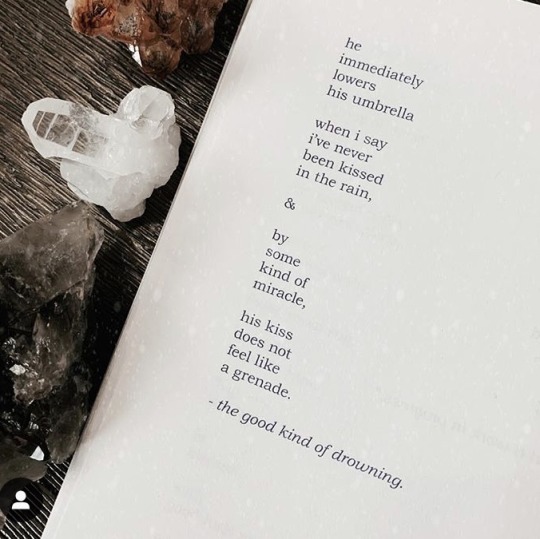
Love is a topic that has been covered (and arguably done to death) by many Instagram poets. An important distinction between Lovelace’s interpretation of love and previous examples we’ve looked at is the use of specificity. Here Lovelace describes an actual situation with a lover, where he gives her a first kiss in the rain. Lovelace uses herself and her lover as characters in the poem, giving the situation a more human, emotional tone. Through Amanda’s emotions attached to the poem, we can more easily relate to and empathize with Amanda when reading. The poem has an added layer of emotional depth during the last stanza. She is surprised that the kiss “doesn’t feel like a grenade”. Here is another example of much being said in a few words. The stanza implies that Amanda still has emotional scars from previous bad relationships or trauma, she is used to kisses feeling explosive or dangerous. This poem is colored with a sense of peacefulness. Finally, Amanda can be pleasantly surprised by a kiss in a relationship. Here, she feels safe and protected after a seemingly long history of pain from which she is still recovering. The mix of melancholy and hope present in the poem partnered with the imagery of a kiss in the rain provides a complete poetic picture and effective emotional piece.

This piece is another example of why Amanda’s work stands out amongst Instagram poets. Although it contains the stereotypical line breaks, the poem still works emotionally and artistically when placed outside of the context of the form. Even when read as a single sentence, the poem contains a meaning to interpret. Much like Lovelace’s other works, this poem seems to be about overcoming trauma or dark emotional states in life. “If after everything I’m still breathing, then there must be a reason even if I haven’t seen it yet” provides a message of hope in a dark world. Sometimes when hard times come around, simply breathing becomes a gift. Breathing is a constant, the life force that allows us to continue living. This poem reminds the reader that simply breathing and surviving hard times is the first step towards healing. The strength it takes to survive a rough patch is reason enough to keep going. Sometimes trauma blinds us to the blessings we have in the world, but it all goes back to that simple breath. The poem also touches upon a sense of hope, as Amanda trusts that she will survive and be alright in the future, even if she does not know all the answers as of yet.
These poems, and Lovelace’s other work, shows that Amanda’s personal thoughts and struggles are a point that makes her poems relatable. Rather than trying to appeal to the masses of “she”’s, Amanda tells her own story in her own way, and manages to be more relatable at the same time. We can all empathize with pain and recovery and seeing a real life perspective on these topics provides a refreshingly human lens with which to view these poems. Amanda’s work exemplifies the idea that the length of poems and the medium with which they are published is not necessarily a determinant of quality. Amanda’s work shines because of the passion, talent, and emotional honesty she possesses. The work I’ve read from Amanda has stayed with me since the first time I read it and I will carry it in my heart as I head into the future.
0 notes
Text
5 Best Barn Heater 2020 Reviews & Buyer Guide
For those who own a racing horse farm like me, they all understand that taking care of their horse is very important. On, chilly days of 9, 10 degrees, horses always want to be warmed. And to bring the best conditions for them, I have learned and tried many types of barn heater. However, until the end, there are only 5 best barn heaters that I like the most. I also discovered that these heaters could use heat pole barns, milking barns, and my garage.
And now, I want to share my experiences over the past three years. Let’s see it!
Top 5 Best Barn Heaters on the Market of 2020
Product Image Product Name Our Rating Price Mr. Heater Corporation F299720 Vent-Free 20,000 BTU Propane Heater 4.9 See latest Price NewAir G73 Hardwired Electric Garage Heater 4.8 See latest Price Heat Storm HS-1500-PHX-WIFI Infrared Heater 4.8 See latest Price Comfort Zone CZ220 Fan-Forced Ceiling Mount Heater 4.8 See latest Price Stiebel Eltron 074058 120-Volt 1500-Watts Wall Mounted Electric Fan Heater 4.7 See latest Price
In-depth 5 Top rated Barn Heaters Reviews
#1 Mr. Heater Corporation F299720 Vent
See Latest Price on Amazon.com
I will begin my best barn heater reviews with the Mr. Heater Corporation F299720 Vent. What I like about this product is the wide-area heating.
To be honest, my barn is quite large (600 square feet). And although I stand outside of the barn, I can still feel the heat provided by this device.
As the seller told me that this product could work for a long time, I decided to try its limitation. And the result is, the machine can heat up the barn for more than 20 hours at its max BTU of 20,000! Isn’t it amazing?
Pros Cons
Wide heating
Can turn off automatically when warm enough
Energy saving
The air on the floor is still cool enough for the animals to feel comfortable
Quite noisy when heating up.
#2 NewAir G73 Hardwired Electric Garage Heater
See Latest Price on Amazon.com
The second heater that I have used in my horse barn is the NewAir G73 Hardwired Electric Garage Heater.
In spite of the fact that this heater is normally mounted on the wall or to the ceiling, I can still modify its direction in order to focus the heat on a specific area. That is all thanks to the adjustable louvers attached to the device.
At the very beginning, I worried quite much that the device would burn my horses with its high heat! But luckily, the machine has not done that. Because the heater has an automatic heat control system, it can modify the temperature in order to keep the animals warm without overheating.
Pros Cons
Easy to install
Put out a great amount of heat
Quite noisy while working.
#3 Heat Storm HS-1500-PHX-WIFI Infrared Heater
See Latest Price on Amazon.com
When it is about 41°F in winter, going outside to change the barn temperature is surely a difficult task! Due to this reason, I required a heater that allows me to control the heat from a far distance. And at the end, the Heat Stork HS-1500-PHX-WIFI has met my needs.
Designed with Smart Wireless Connection technology, the device gives me permission to control it with my phone! All I have to do is download an application, connect this app with the heater through the Internet, and do any command as I desire.
Pros Cons
Powerful heat
Convenient and modern Wifi application
Rather quiet
Not receiving signals if the WIFI is weak.
#4 Comfort Zone CZ220 Fan-Forced Ceiling Mount Heater
See Latest Price on Amazon.com
Among five products on my list, this Comfort Zone CZ220 is the best barn heater that can make sure for me about horse safety.
More specifically, the Comfort Zone company has added a sensor to the machine. This sensor can know when the heater provides too much heat and shut down the device if that case happens.
To know whether the product is on or off, I have to look at the indicator light. When the machine is shut down due to overheating, the light will go off. Really easy to use, right?
Pros Cons
Safe sensor built-in
Strong heat
Sturdy and durable design
Taking a long time to make the room hot.
#5 Stiebel Eltron 074058 Mounted Electric Fan Heater
See Latest Price on Amazon.com
Most recently, I have tested the Stiebel Eltron 074058 mounted electric fan heater. And you know what? This machine has satisfied me with its silent operation.
As I have read from the instruction, this machine is made of galvanized steel. This material works to reduce the operating noise of the device to only 49.7 DB. In the very first place, I have not believed this thing much. But since the heater began to work, I had to think again.
Of course, low noise does not mean low heat. In fact, this product can provide much heat to bring comfort to my horses. With a thermostat temperature range from 41°F to 86°F, I just have to adjust the heat to maximal to protect my animals in the cold days.
Pros Cons
Quiet running
Easy to install
Morden and beautiful design
Low airflow.
Things to consider before buying a barn heater
With the experiences I have so far, I can list here 4 factors you should consider when choosing a heater for your own barn.
1. Size, Attachment, Installation
Sometimes, your barn space can affect the heater size you will choose. And, where to attach or put the heater is also a problem.
If your barn can’t afford a big, powerful heater which stands on the floor, you can choose the alternative which mounted onto the ceiling or the wall.
However, a standalone heater is easily installed as you only need plugging into an electrical outlet, then it goes straight. Meanwhile, a heater mounted onto the wall or ceiling needs more complicated installation in hard wiring or cabling.
2. Heat rating and Barn size
According to your barn size and whether you already have another heating system or not, you will choose a heater with a suitable heat rating.
Normally, the standalone heaters are smaller and designed to add an extra heat source. If your purpose is to avoid freezing in an area of the barn, a standalone heater is a good choice.
Other types mounted onto ceiling or wall are often bigger, which are perfect for a larger heating space.
3. Type
As I know, there are various types of heater to choose: electric, propane gas, natural gas, kerosene, recycled oil, and infrared heaters. Of course, each of them comes with its own advantages or disadvantages, strong heat or weaker heat, costly or cheaper price, etc. that is up to your choice.
Keep reading below for detailed information about types of the heater in accordance with your purpose of heating.
4. Safety
The last factor to consider is the safety of a heater – yes, last but not least. To be honest, leaving the animals or equipment unattended with the heating source days and nights make a bit worry in me.
So, let choose a heater that is guaranteed with safety checks and produce no smoke. You can do this by checking the safety ratings (the customers’ reviews) on your potential heater, or find whether there are any features of extra protection.
How to heat a barn?
1. Make it insulated
Standard barn
To heat a barn, the best thing you can do is to make it insulated properly.
A major of standard American barns are constructed from steel, a material that has no insulation it’s own. Besides, steel can get wide range of temperatures from very hot to very cold, which increases the condensation build-up.
As you may know, condensation and humidity can badly affect your barn infrastructure and animals’ health over time. Your tools and supplies can rust because of the humidity.
To prevent these unwanted things, the indoor temperature of your barn should be steady. That’s why you need to insulate it, keep it warmer when the temperature gets down.
One method that is common for steel-sided barns is spraying foam insulation. It is arguably 50% more effective in steadying the inside temperature.
Depending on how harsh the winter is, you apply the suitable thickness for the foam. Usually, 4” to 6” thickness is fine.
If the winter in your area is not really cold, this layer insulation can be enough to get through to the warm weather. But if it is colder, you might need a supplement heat source like a heater for your barn.
Pole barn
Pole barns are built with wooden posts. They are buried directly into the ground. The floor of a pole barn can be concrete or just dirt which is different from a standard barn.
Typically, this type of barn is used for storing equipment (like tractors, mowers, etc). Sometimes, it is made for workshops.
Similar to the standard one, a pole barn does not have insulation. Hence, it also needs to be insulated.
Some methods to be used are using fiberglass, foam, or cellulose. You can add more heat sources by using barn heaters as well.
2. Choose the correct heater size
As mentioned above, a heater size depends on the barn space.
Heater size is determined by the BTU rating. The larger the heated space is, the higher the BTU rating is needed.
Normally, a heater of 10,000 – 30,000 BTUs can accommodate a barn of 300 – 1,000 square feet in size. For over 1,000 square feet barn, heaters with 30,000 – 400,000 BTUs are better.
A heater with a higher BTU rating can heat larger space, but it will cost you more and use more energy. So, you should calculate your heating space accurately to minimize the cost.
Here is the way to calculate your barn.
Measure the area height, width, length
Multiply 3 above measurements, you have the Cubic feet
Multiply the Cubic feet by 0.133, then multiply by the desired heat increase
Then you have BTUs required.
Things to notice before heating a barn
1. Your barn keeps livestock
If your barn keeps livestock, you should know that the reaction to temperatures of different animals is not the same. Some livestock is quite resistant to cold temperatures, so their health might be worse when more heat is added.
Hence, you need to consider the average winter temperature in your area and the temperature that your animals need.
Horses, cows, sheep, pigs, and mules are just fine in cold weather, but if the temperature is below 30 to 35ºF, they will need heaters.
Other animals such as chickens, rabbits, etc, who are smaller, should be added more heat when the temperature dips to below 40ºF.
2. Your barn keeps equipment
Don’t think that a barn keeping equipment has no need for a heater. Well, even the equipment is not an alive thing, it still can be damaged or cracked if the temperature goes too low.
Some tools can need more time to get started or can be strained if used without enough time to heat up.
Adding more heat to the barn can also make you comfortable whenever you work here.
3. Legal restrictions
Last but not least, you have to ensure what type of heaters is legally used for barns in your area.
If you have a mistake, you might receive fines and the cost of removing and replacing the heaters that you have installed.
FAQs
1. How warm should I keep my barn?
Depending on each horse’s coat, their most comfortable temperature ranges from 18° to 59° F. So, you shouldn’t keep warm your barn more than 59° F.
If you keep your barn too warm, your horses may not grow their winter coat. And that leads troubles when they are out in the cold weather.
2. How cold is too cold for horses?
Horses can tolerate temperature at 0° F or slightly below 0° F if there is no wind and moisture.
If they have a shelter, they can tolerate temperature at -40° F. So, below -40° F will be too cold for horses.
3. Are heated barns bad for horses?
If your barn is heated properly, you are making a better situation for your horses.
But if you do it wrong, the humidity may increase which leads to the development of bacteria. Remember good ventilation is as important as enough heat in the barn.
4. Do horses get cold in the snow?
Horses can handle in cold weather but not in harsh cold weather since they are mammals. They can survive in the snow but chomping the snow and ice will not prevent them from dehydrating. Hence, remember to provide them clean water and fresh food.
Conclusion
All five types of products on the list are very good and popular on the market today. However, in my opinion, the NewAir G73 Hardwired Electric Garage Heater is a perfect choice. I love the heating ability of this device as well as the extremely convenient Wifi software. Moreover, for a horse barn like mine, I think this is the best barn heater!
A new article about the best shed kit will be updated soon! For more reference, visit and follow my website.
And now, thank you for reading!
Source: 5 Best Barn Heater 2020 Reviews & Buyer Guide
source https://sandcreekfarm.net/best-barn-heater-reviews/
0 notes
Text
Approach Anxiety Cured In Three Simple Steps
You can find the original article at http://www.socialattraction.co.uk Connect with us Google+
So, how exactly do we cure approach anxiety? Well, first of all, approach anxiety is a fear of approaching women. And arguably, this fear is almost as bad or, if not, as bad as the fear of public speaking.
So, I’m going to share three funny stories from the training courses that I’ve hosted over the years, and off the back of the stories, you will be able to work out what strategies I implemented to help my clients overcome approach anxiety.
And what this means is that, subtly, you will also understand ways that can work for you. I always believe in the power of influence rather than just directly telling you what to do. I always feel like stories are just a much better way of implementing things into your life. So, let’s begin with the first one, which is about an investment banker who came to one of my training courses.
So, we were in central London and we went to Trafalgar Square. This was about four years ago when we used to do training courses, taking people out onto the street and help them overcome approach anxiety.
Now, in this situation, this guy was extremely wealthy, lived offshore and very, very confident, wore a really nice suit, nice watch, nice shoes, good haircut, good style, looked like the real deal. I always find it interesting when people come to my training courses where they just appear so confident on the outside and then the reasons why they booked onto one of my courses become apparent. So, we headed down to Trafalgar Square, which is a really good place of practising speaking to people. And as usual, we run through the normal procedure, get to know each other. And when we arrive there, I just asked him to ask someone to take a photograph of him.
So, I said, “Just just go and ask that guy to take a photo,” and he said, “No, no, I can’t do that.” And I said, “You’re in a tourist area. Just ask someone to take a photo of you.” And he said, “No, no, no. No, no. No. I can’t do that. I can’t do that.” And it was such a paradigm shift for me in the way that I viewed this guy that I couldn’t help but start laughing, and it’s the first time I’d really lost my professional air of wisdom on training courses because I’ve seen everything so many different times. But in this situation, I just found it funny and I couldn’t help myself. I started laughing, and he was saying, “You’re not taking this seriously,” and I couldn’t help but start laughing. And the interesting thing was that his fear wasn’t as bad as how funny I found the situation.
So, after a few seconds, he kind of loosened up and began to start laughing and he could see the funny side of what was going on. And I said to him, “Listen, I’m not laughing at you. It’s just the situation is amusing.” And I said to him, “Look, what we can do, if you can’t even ask someone to a photograph of you,” which there are many people that can’t actually do that and most people think approach anxiety’s about actually physically starting a conversation and continuing it. It’s not. Approach anxiety is just the fear. And what we did is I just said to him, “Well, are you happy getting close to someone just within a metre and a half of them?” And he said, “Yeah, I am.”
This is known as getting proximity and it’s probably the first step for a lot of people in overcoming their fear, and it’s really simple.
You just break it down to the simplest step. What’s the first step of speaking to someone? Well, really, you have to get close enough to speak to them. Once you’re close enough, you can then start a conversation. So, getting physically close to someone is a really good first step. Now, if you’re listening to this and you think to yourself, “Well, I can’t even get physically close to someone,” the step before that is to imagine it.
So, as you listen to this, if you just imagine yourself physically getting close to someone. And by physically getting close, I mean close enough to start a conversation. You don’t want to get too close to someone, but about a metre, metre and a half away is great. Some ways in which you can do this, as you walk into a cafe or bar, most guys that see attractive women tend to rush onto the other side of the bar and then go, “Right, how do we go about doing this?” And that’s just going to make your anxiety worse.
So, the easiest thing that you can do is just to physically go and get close to someone. And when you walk in, if there’s a chair near someone that you find attractive, just go and sit in that chair, and that’s a great first step in overcoming your fear of starting a conversation with women. Now, onto my second story, which is about a Russian girl when I was hosting a training course in Bucharest.
Now, I did a European tour, which was… I took my clients to three different cities over a three-month period over the summer period in the UK, and it was marvellous. It was such good fun. It was just great team-building and just a wonderful experience.
Here’s what happened. It was quite amusing. I arrived in Bucharest before everyone else because I’d never been to a foreign city and hosted a training course. Now, I assumed within a couple of days, it would be no problem. I would be thinking, “This will just be the same as what it is in the UK.” And what I found after a day is that it was a million times harder. Not only was the level of English lower than what I was expecting in a Western country, the people that lived there were very unreceptive to even asking directions or where things are, even though you were tourists.
So, this was a very difficult situation I found myself in because I now was beginning to feel anxiety about approaching people, and I found myself in a situation where the clock was ticking. And the following day, I was hosting my training course on how to do it. So, I won’t reveal how I overcame the issue that day, but what I will do is follow up with a story of one of my clients the next day.
And he’s someone who was about 25 years old, quite an energetic individual. And what I decided to do with him was to energise him to get him into a really high-end physical state, and the reason why you do this is because if you feel good about yourself, you’re going to have a really strong aura. And my belief is that if your aura is stronger than the person that you’re speaking to, then your frame will eventually come across. So, what we did, I taught him something called power posing.
Now, power posing is when you pull a pose with your body like you’ve won the hundred-metre sprint, or you’ve won the Olympics, or you’ve just scored a goal in a local football game. It’s almost like a celebratory pose, the idea being that you pull the pose as a champion and your mind energises itself.
So, what I did is I taught him about power posing. And the very first girl that he approached was a Russian girl who was on holiday in Bucharest, and he spent the next three days with her, which was interesting because, in my head, the course was going to go different to that. I was going to take them through step-by-step processes of energising yourself this way, this is a different way of doing it. And low and behold, the very first approach that he did made him have the ability to spend time with someone immediately.
I mean, this guy had done some courses with me in the UK anyway, so he was a very good communicator with women anyway. So, it was transferring that over to a different city, and that’s something interesting as well. Getting out of your comfort zone, if you think you’re good in any area of your life, push it further. Go to a different country and see how good you are over there. That’s an interesting facet of my life over the past five, six, seven years of coaching this in multiple places.
And the last thing I wanted to talk about was a story about a client of mine who came over from New Zealand and he was really laid back. I actually really like this guy. He was cool, calm, collected, but there was no rushing him. I mean, there’s no way this guy was rushing to talk to anyone. It was just… Unless someone was static or walking slower than him, which was quite unlikely, he just wasn’t going to start a conversation with someone, but he still had anxiety.
What I realised was that we’re not going to be able to energise this guy’s body because he’s just not that type of guy. He’s too laid back. So, what we did, we came up with the personal mantra.
Now, if you imagine a power pose energises your body, what a personal mantra does, it energises your mind. And what I wanted to do with this guy was to enable him to just get rid of his anxiety. And what we find with approach anxiety is that you’ve got a two to three-second window before it hits you. So, if you can do something within that two to three-second window, you can prevent the fear from coming up in the first place. And so what we did, we came up with a mantra, and as you’re listening to this, you can come up with your own if you just answer the following question.
“If I was holding a gun to your head and you had three seconds to give your only son one piece of positive advice, what would it be?”
And as you can imagine, multiple answers can come to you. A few good ones, “Just do it”, which is obviously the Nike slogan. Just do it, anything positive. Now, what this is, this is your own personal mantra. Whatever it is that you’ve got, you can also use a mantra of one of your icons in life. If you can imagine Arnold Schwarzenegger is telling you, “You can do it,” then obviously that’s also very powerful, but the aim is to have some positive words you can say to yourself as soon as you see an attractive girl.
What happened with this guy from New Zealand is that when I taught him about a personal mantra, he literally went from having anxiety to none whatsoever. He was a smart guy, anyway. So, just giving him one basic tool that worked was fantastic. So, this guy went from having severe anxiety to none, and all you did was have a personal mantra, which was something like, “You can do it.”
And from that point on, although he wasn’t going to be energised, at least he was relaxed with no fear. And what I’ve done during this episode is just explained three different ways through three of the stories from my training courses on how you can overcome approach anxiety. If we just wanted to be on the nose with all of them, very simple. Number one is called getting proximity, and that just means simplify the process, go and get close to someone.
When you feel comfortable with just getting close to people, you can then start a conversation. But with approach anxiety, it really is just a case of getting physically close enough to someone to start conversation and that will really help. The second one was to energise your body through power posing, and that’s going to put you in a great mental state. And the final one was to energise your mind through a personal mantra.
Now, all of these have one thing in common. Ideally, you’d like to do them in the first two to three seconds of seeing someone who you find attractive, because the way that our minds work, we have a two or three second grace period before the fear sets in. So, anyone of these three is going to be extremely powerful if you’re able to implement it into your life.
Listen to The Gary Gunn Show Podcast #111 – Approach Anxiety Cured In Three Simple Steps
Want to overcome your approach anxiety? – View our upcoming courses here
0 notes